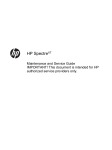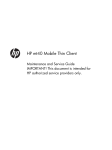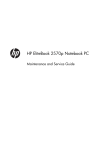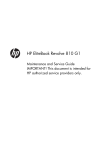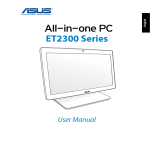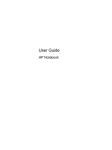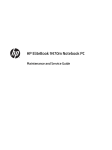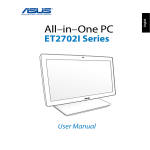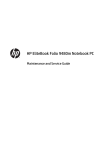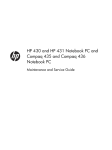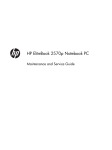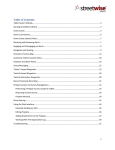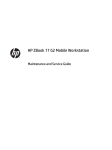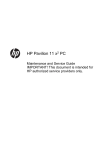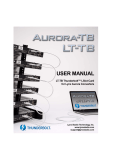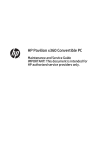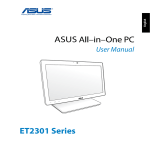Download HP 15-4010nr Maintenance and Service Guide
Transcript
HP SpectreXT TouchSmart Maintenance and Service Guide © Copyright 2012 Hewlett-Packard Development Company, L.P. Bluetooth is a trademark owned by its proprietor and used by Hewlett-Packard Company under license. Intel and Core are U.S. registered trademarks of Intel Corporation. Microsoft, Windows, and Windows Vista are U.S. registered trademarks of Microsoft Corporation. SD Logo is a trademark of its proprietor. The information contained herein is subject to change without notice. The only warranties for HP products and services are set forth in the express warranty statements accompanying such products and services. Nothing herein should be construed as constituting an additional warranty. HP shall not be liable for technical or editorial errors or omissions contained herein. First Edition: November 2012 Document Part Number: 682637-001 Safety warning notice WARNING! To reduce the possibility of heat-related injuries or of overheating the device, do not place the device directly on your lap or obstruct the device air vents. Use the device only on a hard, flat surface. Do not allow another hard surface, such as an adjoining optional printer, or a soft surface, such as pillows or rugs or clothing, to block airflow. Also, do not allow the AC adapter to contact the skin or a soft surface, such as pillows or rugs or clothing, during operation. The device and the AC adapter comply with the user-accessible surface temperature limits defined by the International Standard for Safety of Information Technology Equipment (IEC 60950). iii iv Safety warning notice Table of contents 1 Product description ........................................................................................................... 1 2 External component identification ..................................................................................... 4 Display ................................................................................................................................... 4 Buttons, speakers, and antennas ................................................................................................ 5 Keys ....................................................................................................................................... 6 Lights ...................................................................................................................................... 7 TouchPad ................................................................................................................................ 8 Left side .................................................................................................................................. 9 Right side .............................................................................................................................. 10 Bottom .................................................................................................................................. 12 3 Illustrated parts catalog .................................................................................................. 13 Service tag ............................................................................................................................ 14 Computer major components ................................................................................................... 15 Display assembly subcomponents ............................................................................................. 19 Mass storage device ............................................................................................................... 21 Miscellaneous parts ................................................................................................................ 21 Sequential part number listing .................................................................................................. 22 4 Removal and replacement procedures ............................................................................ 27 Preliminary replacement requirements ....................................................................................... 27 Tools required ......................................................................................................... 27 Service considerations ............................................................................................. 27 Plastic parts ............................................................................................. 27 Cables and connectors ............................................................................. 27 Drive handling ......................................................................................... 28 Grounding guidelines .............................................................................................. 28 Electrostatic discharge damage .................................................................. 28 Packaging and transporting guidelines ........................................ 30 Component replacement procedures ........................................................................................ 32 v Service tag ............................................................................................................. 32 Bottom cover .......................................................................................................... 33 Battery ................................................................................................................... 35 RTC battery ............................................................................................................ 36 WLAN module ........................................................................................................ 37 Fan ....................................................................................................................... 39 Solid-state drive ...................................................................................................... 40 Power button board ................................................................................................. 41 Hard drive ............................................................................................................. 43 Display assembly subcomponents .............................................................................. 45 TouchPad ............................................................................................................... 52 Front speakers ........................................................................................................ 54 TouchPad LED board ............................................................................................... 56 Power connector cable ............................................................................................ 57 Multimedia board ................................................................................................... 59 Memory module ...................................................................................................... 60 System board ......................................................................................................... 62 Heat sink ................................................................................................................ 65 RJ-45 jack cover ...................................................................................................... 67 Keyboard ............................................................................................................... 69 Rear speakers ......................................................................................................... 71 WLAN antenna ...................................................................................................... 72 5 Using Setup Utility (BIOS) and System Diagnostics ........................................................... 74 Starting Setup Utility (BIOS) ..................................................................................................... 74 Updating the BIOS ................................................................................................................. 74 Determining the BIOS version ................................................................................... 74 Downloading a BIOS update .................................................................................... 75 Using System Diagnostics ........................................................................................................ 76 6 Specifications ................................................................................................................. 77 Computer specifications .......................................................................................................... 77 15.6-inch SGA display specifications ....................................................................................... 78 Hard drive specifications ........................................................................................................ 79 7 Backing up, restoring, and recovering ............................................................................ 80 Creating recovery media and backups ..................................................................................... 80 Creating HP Recovery media .................................................................................... 81 Restore and recovery .............................................................................................................. 82 Using Windows Refresh for quick and easy recovery ................................................... 83 vi Remove everything and reinstall Windows ................................................................. 84 Recovering using HP Recovery Manager .................................................................... 84 What you need to know ............................................................................ 85 Using the HP Recovery partition to recover a minimized image (select models only) .................................................................................. 85 Using HP Recovery media to recover .......................................................... 86 Changing the computer boot order ............................................................. 86 Removing the HP Recovery partition .......................................................................... 86 8 Power cord set requirements .......................................................................................... 87 Requirements for all countries .................................................................................................. 87 Requirements for specific countries and regions ......................................................................... 88 9 Recycling ........................................................................................................................ 89 Index ................................................................................................................................. 90 vii viii 1 Product description Category Description Product Name HP SpectreXT TouchSmart Processors ● Intel® Quad Core® i7-3537U 2.00-GHz processor (turbo up to 3.10-GHz), 1600-MHz FSB, 4.00-MB L3 cache, 17 W) ● Intel Quad Core i7-3517U 1.900-GHz processor (turbo up to 3.00-GHz), 1600-MHz FSB, 4.00-MB L3 cache, 17 W) ● Intel Dual Core i5-3337U 1.800-GHz processor (turbo up to 2.700-GHz), 1600-MHz FSB, 3.00-MB L3 cache, 17 W) ● Intel Dual Core i5-3317U 1.700-GHz processor (turbo up to 2.600-GHz), 1600-MHz FSB, 3.00-MB L3 cache, 17 W) Chipset Mobile Intel HM77 PCH (platform controller hub) chipset Graphics Intel HD Graphics 4000 integrated universal memory architecture (UMA) graphics Support for BD playback with HD Decode and DX11 Panel 15.6-in full high-definition (FHD), wide light-emitting diode (WLED), BrightView (BV), UWVA (1920×1080), slim (3.2-mm) display with webcam and microphone Touchscreen and MultiTouch enabled Typical brightness: 300 nits Memory One customer-accessible/upgradable memory module slot + 4-GB on the system board Support for DDR3L (1600-MHz) dual channel Support for 8192-MB of system RAM in the following configurations: ● 8192-MB (4096-MB memory module + 4096-MB on system board) ● 6144-MB (2048-MB memory module + 4096-MB on system board) ● 4096-MB (4096-MB on system board) 1 Category Description Hard drive Support for 6.35-cm (2.5-in) hard drives in 7.0-mm (.28-in) thickness Serial ATA Support for hard drive configuration as cache 32-GB mSATA (installed with hard drive only) Support for Accelerometer hard drive protection Support for the following hard drives: Solid-state drive ● 500-GB, 7200-rpm, 7.0-mm ● 500-GB, 5400-rpm, 7.0-mm Support for mSATA solid-state drives Serial ATA III Support for the following single solid-state drive configurations: ● 256-GB mSATA ● 128-GB mSATA Support for Intel Smart Response Technology 32-GB solid-state drive Audio and video Two high-performance Premium-branded speakers mounted in bass reflex enclosures Dual-array microphones with appropriate beam-forming, echo-cancellation, noise-suppression software HD Audio (92HD99) Beats signature audio profile applied to both headphones and external speakers Separate discrete amplifiers for headphone and audio out jacks Supports Microsoft Premium requirements Integrated HP TrueVision HD slim webcam (fixed [no tilt], activity LED, 1280×720 by 24 frames per second) Dual array digital microphones with appropriate beam-forming, echo-cancellation, noisesuppression software Ethernet Integrated 10/100/1000 RTL8111F network interface card (NIC) Wireless Integrated wireless local area network (WLAN) options by way of wireless module Support for the Intel Centrino Advanced-N 6235 Combo Adapter Support for Intel Wireless Display (Wi-Di) 2 Chapter 1 Product description Category Description External media cards 2-in-1 Digital Media Reader Slot Digital Media Slot with push-push technology, supporting the following digital card formats: Ports Keyboard/pointing devices ● Secure Digital (SD) Memory Card ● Secure Digital High Capacity (SDHC) Memory Card ● Secure Digital Extended Capacity (SDxC) Memory Card ● MultiMediaCard (MMC) ● Audio-in (mono microphone)/audio-out (stereo headphone) combo jack ● HDMI v1.4a supporting up to 1920×1200 @ 60Hz with HDCP key ● AC adapter ● RJ-45 (Ethernet) ● USB 3.0 port (two ports on left side) ● USB 2.0 port (one port on right side), supports USB sleep and charge Full-size, backlit, island-style keyboard Gesture support: MultiTouch gestures enabled, two-finger scrolling, and pinchzoom as default Taps enabled by default Support for ImagePad with gesture support image sensor, scroll, pinch, zoom, rotate, and 3finger flick) Power requirements Support for 65-W AC adapter (non-PFC, 3-wire) Support for 4-cell, 48-Wh, 3.27-Ah battery (Li-ion) Security Support for security cable lock Support for Trusted Platfom Module (TPM) Support for Intel AT-p Ready (in BIOS) Operating system Preinstalled: Windows® 8 Professional 64-bit and Windows 8 Standard 64-bit Serviceability End user replaceable part: AC adapter 3 2 External component identification Display Item Component Description (1) Internal display switch Turns off the display and initiates Sleep if the display is closed while the power is on. NOTE: The internal display switch is not visible from the outside of the computer. (2) Internal microphones (2) Record sound. (3) Webcam light On: The webcam is in use. (4) Webcam Records video, captures still photographs, and provides access to video conferences and online chat by means of streaming video. From the Start screen, type c, and then select CyberLink YouCam. 4 Chapter 2 External component identification Buttons, speakers, and antennas Item Component Description (1) Power button ● When the computer is off, press the button to turn on the computer. ● When the computer is in the Sleep state, press the button briefly to exit Sleep. ● When the computer is in Hibernation, press the button briefly to exit Hibernation. CAUTION: Pressing and holding down the power button will result in the loss of unsaved information. If the computer has stopped responding and Microsoft Windows shutdown procedures are ineffective, press and hold the power button down for at least 5 seconds to turn off the computer. NOTE: For select models, the Intel Rapid Start Technology feature is enabled at the factory. Rapid Start Technology allows your computer to resume quickly from inactivity. To learn more about your power settings: (2) WLAN antennas (2)* 1. From the Start screen, type p. 2. In the search box, type power. 3. Select Settings, and then select Power options. Send and receive wireless signals to communicate with WLANs. Buttons, speakers, and antennas 5 Item Component Description (3) Speakers (2) Produce sound. *The antennas are not visible from the outside of the computer. For optimal transmission, keep the areas immediately around the antennas free from obstructions. For wireless regulatory notices, see the section of the Regulatory, Safety, and Environmental Notices that applies to your country or region. To access this guide, select the HP Support Assistant app from the Start screen, select My computer, and then select User guides. Keys Item Component Description (1) esc key Displays system information when pressed in combination with the fn key. (2) fn key Executes frequently used system functions when pressed in combination with the b key or the esc key. (3) Windows logo key Returns you to the Start screen from an open app or the Windows desktop. NOTE: Pressing the Windows logo key again will return you to the previous screen. 6 (4) Action keys Execute frequently used system functions. (5) Windows application key Displays options for a selected object. Chapter 2 External component identification Lights Item Component Description (1) Power light ● White: The computer is on. ● Blinking white: The computer is in the Sleep state, which is an energy-saving mode. The computer shuts off power to the display and other unneeded components. ● Off: The computer is off or in Hibernation. Hibernation is an energy-saving mode that uses the least amount of power to preserve your work. NOTE: For select models, the Intel Rapid Start Technology feature is enabled at the factory. Rapid Start Technology allows your computer to resume quickly from inactivity. (2) Keyboard backlight light Identifies the keyboard backlight action key. (3) Mute light ● Amber: Computer sound is off. ● Off: Computer sound is on. ● White: An integrated wireless device, such as a WLAN device and/or a Bluetooth device, is on. ● Amber: All wireless devices are off. (4) Wireless light Lights 7 Item Component Description (5) Caps lock light On: Caps lock is on, which switches the keys to all capital letters. (6) TouchPad light ● On: The TouchPad is off. ● Off: The TouchPad is on. TouchPad Item Component Description (1) TouchPad on/off button Turns the TouchPad on or off. (2) TouchPad light ● On: The TouchPad is off. ● Off: The TouchPad is on. (3) TouchPad zone Moves the on-screen pointer and selects or activates items on the screen. NOTE: 8 The TouchPad also supports gestures. (4) Left TouchPad button Functions like the left button on an external mouse. (5) Right TouchPad button Functions like the right button on an external mouse. Chapter 2 External component identification Left side Item Component Description (1) RJ-45 (network) jack lights (2) ● White: The computer is connected to a network. ● Amber: The computer is connected to a network and activity is occurring on the network. (2) RJ-45 (network) jack Connects a network cable. (3) HDMI port Connects an optional video or audio device, such as a high-definition television, any compatible digital or audio component, or a high-speed HDMI device. (4) Thunderbolt DisplayPort Connects an optional high-resolution display device or a high-performance data device. NOTE: Thunderbolt is new technology. Install all the latest drivers for your Thunderbolt device before connecting the device to the Thunderbolt DisplayPort. Thunderbolt cable and Thunderbolt device (sold separately) must be compatible with Windows. To determine whether your device is Thunderbolt Certified for Windows, see https://thunderbolttechnology.net/ products. (5) USB 3.0 ports (2) Connect optional USB 3.0 devices and provide enhanced USB power performance. NOTE: The USB 3.0 port is also compatible with USB 1.0 and USB 2.0 devices. Left side 9 Item Component Description (6) Hard drive light ● Blinking white: The hard drive is being accessed. ● Amber: HP 3D DriveGuard has temporarily parked the hard drive. ● White: The computer is on. ● Blinking white: The computer is in the Sleep state, which is an energy-saving mode. The computer shuts off power to the display and other unneeded components. ● Off: The computer is off or in Hibernation. Hibernation is an energy-saving mode that uses the least amount of power to preserve your work. (7) Power light NOTE: For select models, the Intel Rapid Start Technology feature is enabled at the factory. Rapid Start Technology allows your computer to resume quickly from inactivity. Right side 10 Item Component Description (1) Digital Media Card Reader Supports the following digital card formats: Chapter 2 External component identification ● Secure Digital (SD) Memory Card ● Secure Digital High Capacity (SDHC) Memory Card ● Secure Digital Extended Capacity (SDxC) Memory Card ● MultiMediaCard (MMC) Item Component Description (2) Audio-out (headphone) jack/Audio-in (microphone) jack Connects an optional device such as a headset, power stereo speakers, headphones, earbuds, television audio, or a headset microphone. WARNING! To reduce the risk of personal injury, adjust the volume before putting on headphones, earbuds, or a headset. For additional safety information, refer to the Regulatory, Safety, and Environmental Notices. To access this guide, from the Start screen, select the HP Support Assistant app, select My computer, and then select User guides. NOTE: When a device is connected to the jack, the computer speakers are disabled. (3) USB 2.0 charging port Connects an optional USB device. This port can also charge select models of cell phones and MP3 players, even when the computer is off. NOTE: A USB charging port (also referred to as a USB powered port) allows you to charge connected USB devices. Some USB devices require power and require you to use a powered port. (4) AC adapter light ● White: The AC adapter is connected and the battery is charged. ● Amber: The AC adapter is connected and the battery is charging. ● Off: The computer is using battery power. (5) Power connector Connects an AC adapter. (6) Security cable slot Attaches an optional security cable to the computer. NOTE: The security cable is designed to act as a deterrent, but it may not prevent the computer from being mishandled or stolen. Right side 11 Bottom Item Component Description (1) Speakers (2) Produce sound. (2) Vent Enables airflow to cool internal components. NOTE: The computer fan starts up automatically to cool internal components and prevent overheating. It is normal for the internal fan to cycle on and off during routine operation. 12 Chapter 2 External component identification 3 Illustrated parts catalog 13 Service tag When ordering parts or requesting information, provide the computer serial number and model number provided on the service tag. 14 Item Description Function (1) Product name This is the product name affixed to the front of the computer. (2) Serial number (s/n) This is an alphanumeric identifier that is unique to each product. (3) Part number/Product number (p/n) This number provides specific information about the product's hardware components. The part number helps a service technician to determine what components and parts are needed. (4) Warranty period This number describes the duration of the warranty period for the computer. (5) Model description This is the alphanumeric identifier used to locate documents, drivers, and support for the computer. Chapter 3 Illustrated parts catalog Computer major components Computer major components 15 Item Component Spare part number (1) Display assembly: The display assembly is spared at the subcomponent level only. For more display assembly spare part information, see Display assembly subcomponents on page 19. (2) Top cover: Top cover for use only with keyboard spare part kits 700807-031, 700807-041, 700807-051, 700807-061, 700807-071, 700807-131, 700807-141, 700807-161, 700807-A41, 700807-BB1, 700807-BG1, 700807-DB1, and 700807-DH1. 701824-001 Top cover for use only with keyboard spare part kits 700807-001, 700807-151, 700807-171, 700807-251, and 700807-B31. 701823-001 (3) Power button board (includes cable) 700891-001 (4) TouchPad LED board (includes cable) 701819-001 (5) TouchPad (includes cable) 701825-001 (6) Antenna Kit (includes left and right WLAN antenna cables and transceivers) 700796-001 (7) Rear speakers (includes left and right rear speakers, cables, and 2 rubber isolators) 701821-001 Keyboard with backlight and pointing stick (includes keyboard cable, keyboard backlight cable, keyboard shield, and pointing stick cable): Includes: (8a) 16 Keyboard for use in Belgium 700807-A41 For use in Canada 700807-DB1 For use in Denmark, Finland, and Norway 700807-DH1 For use in France 700807-051 For use in Germany 700807-041 For use in Greece 700807-151 For use in Israel 700807-BB1 For use in Italy 700807-061 For use in Latin America 700807-161 For use in the Netherlands 700807-B31 For use in Portugal 700807-131 For use in Russia 700807-251 For use in Saudi Arabia 700807-171 For use in Spain 700807-071 For use in Switzerland 700807-BG1 For use in Turkey 700807-141 For use in the United Kingdom and Singapore 700807-031 For use in the United States 700807-001 Chapter 3 Illustrated parts catalog Item Component (8b) Keyboard shield (9) System board (includes processor and replacement thermal material): Spare part number Equipped with an Intel Quad Core i7-3537U 2.00-GHz processor (turbo up to 3.10GHz), 1600-MHz FSB, 4.00-MB L3 cache, 17 W, and the Windows 8 Professional operating system without trusted platform module security for use only in the People's Republic of China and Russia 715044-601 Equipped with an Intel Quad Core i7-3537U 2.00-GHz processor (turbo up to 3.10GHz), 1600-MHz FSB, 4.00-MB L3 cache, 17 W, and the Windows 8 Standard operating system without trusted platform module security for use only in the People's Republic of China and Russia 715044-501 Equipped with an Intel Quad Core i7-3537U 2.00-GHz processor (turbo up to 3.10GHz), 1600-MHz FSB, 4.00-MB L3 cache, 17 W, and the Windows 7 operating system without trusted platform module security for use only in the People's Republic of China and Russia 715044-001 Equipped with an Intel Quad Core i7-3517U 1.90-GHz processor (turbo up to 3.00GHz), 1600-MHz FSB, 4.00-MB L3 cache, 17 W, and the Windows 8 Standard operating system without trusted platform module security for use only in the People's Republic of China and Russia 704055-501 Equipped with an Intel Quad Core i7-3517U 1.90-GHz processor (turbo up to 3.00GHz), 1600-MHz FSB, 4.00-MB L3 cache, 17 W, and the Windows 7 operating system without trusted platform module security for use only in the People's Republic of China and Russia 704055-001 Equipped with an Intel Quad Core i7-3517U 1.90-GHz processor (turbo up to 3.00GHz), 1600-MHz FSB, 4.00-MB L3 cache, 17 W, and the Windows 8 Professional operating system with trusted platform module security for use in all countries and regions except the People's Republic of China and Russia 700814-601 Equipped with an Intel Quad Core i7-3517U 1.90-GHz processor (turbo up to 3.00GHz), 1600-MHz FSB, 4.00-MB L3 cache, 17 W, and the Windows 8 Standard operating system with trusted platform module security for use in all countries and regions except the People's Republic of China and Russia 700814-501 Equipped with an Intel Quad Core i7-3517U 1.90-GHz processor (turbo up to 3.00GHz), 1600-MHz FSB, 4.00-MB L3 cache, 17 W, and the Windows 7 operating system with trusted platform module security for use in all countries and regions except the People's Republic of China and Russia 700814-001 Equipped with an Intel Dual Core i5-3337U 1.80-GHz processor (turbo up to 2.70GHz), 1600-MHz FSB, 3.00-MB L3 cache, 17 W, and the Windows 8 Professional operating system without trusted platform module security for use only in the People's Republic of China and Russia 715045-601 Equipped with an Intel Dual Core i5-3337U 1.80-GHz processor (turbo up to 2.70GHz), 1600-MHz FSB, 3.00-MB L3 cache, 17 W, and the Windows 8 Standard operating system without trusted platform module security for use only in the People's Republic of China and Russia 715045-501 Equipped with an Intel Dual Core i5-3337U 1.80-GHz processor (turbo up to 2.70GHz), 1600-MHz FSB, 3.00-MB L3 cache, 17 W, and the Windows 7 operating system without trusted platform module security for use only in the People's Republic of China and Russia 715045-001 Computer major components 17 Item Component Spare part number Equipped with an Intel Dual Core i5-3317U 1.70-GHz processor (turbo up to 2.60GHz), 1600-MHz FSB, 3.00-MB L3 cache, 17 W, and the Windows 8 Standard operating system without trusted platform module security for use only in the People's Republic of China and Russia 704056-501 Equipped with an Intel Dual Core i5-3317U 1.70-GHz processor (turbo up to 2.60GHz), 1600-MHz FSB, 3.00-MB L3 cache, 17 W, and the Windows 7 operating system without trusted platform module security for use only in the People's Republic of China and Russia 704056-001 Equipped with an Intel Dual Core i5-3317U 1.70-GHz processor (turbo up to 2.60GHz), 1600-MHz FSB, 3.00-MB L3 cache, 17 W, and the Windows 8 Professional operating system with trusted platform module security for use in all countries and regions except the People's Republic of China and Russia 700816-601 Equipped with an Intel Dual Core i5-3317U 1.70-GHz processor (turbo up to 2.60GHz), 1600-MHz FSB, 3.00-MB L3 cache, 17 W, and the Windows 8 Standard operating system with trusted platform module security for use in all countries and regions except the People's Republic of China and Russia 700816-501 Equipped with an Intel Dual Core i5-3317U 1.70-GHz processor (turbo up to 2.60GHz), 1600-MHz FSB, 3.00-MB L3 cache, 17 W, and the Windows 7 operating system with trusted platform module security for use in all countries and regions except the People's Republic of China and Russia 700816-001 (10) RJ-45 jack cover 701816-001 (11) Solid-state drive: (12) 18 256-GB 700813-001 128-GB 700812-001 32-GB 700811-001 Memory module (PC3-12800, 1666-MHz, DDR3): 4-GB 691740-001 2-GB 691739-001 (13) Memory shield 701817-001 (14) Intel Centrino Advanced-N 6235 Combo Adapter 670292-005 (15) Fan (includes cable) 700803-001 (16) Heat sink (includes replacement thermal material) 700804-001 (17) Multimedia board (includes audio port, Card Reader, USB port, and cable) 701820-001 (18) Front speakers (includes left and right front speakers, cables, and 4 rubber isolators) 700810-001 (19) RTC battery (includes cable and double-sided tape) 686922-001 (20) Hard drive (does not include hard drive bracket, hard drive connector cable, or screws): 500-GB, 7200-rpm, 7.0-mm hard drive 703267-001 500-GB, 5400-rpm, 7.0-mm hard drive 683802-001 Chapter 3 Illustrated parts catalog Item Component Spare part number Hard Drive Hardware Kit (not illustrated, includes hard drive bracket, hard drive connector cable, and screws) 700805-001 (21) Power connector cable (includes bracket) 700802-001 (22) 4-cell, 48-Wh, 3.27-Ah battery (Li-ion) 697311-001 (23) Bottom cover (includes 4 rubber feet) 700798-001 Display assembly subcomponents Item Component Spare part number (1) Display bezel 700799-001 (2) Display panel (15.6-in, HD, LED, BrightView [1920×1080], slim [3.2-mm], UWVA) 700808-001 (3) Webcam/microphone module 700818-001 (4) Display panel cable (includes webcam/microphone module cable) 700800-001 Display assembly subcomponents 19 Item 20 Component Spare part number Display panel touch cable (not illustrated) 712412-001 Display enclosure, includes: 700797-001 (5) Left and right display hinge covers (6) Left and right display hinges (7) Display enclosure Chapter 3 Illustrated parts catalog Mass storage device Item Description Spare part number (1) Hard drive (does not include hard drive bracket, hard drive connector cable, or screws): 500-GB, 7200-rpm, 7.0-mm hard drive 703267-001 500-GB, 5400-rpm, 7.0-mm hard drive 683802-001 Hard Drive Hardware Kit, includes: 700805-001 (2) Hard drive bracket (3) Hard drive connector cable Hard drive bracket screws (not illustrated) (4) Hard drive space cover (5) mSATA solid-state drive: 712413-001 256-GB 700813-001 128-GB 700812-001 32-GB 700811-001 Miscellaneous parts Component Spare part number 65-W AC adapter (non-PFC, 3-wire) 693715-001 HDMI-to-VGA adapter 701943-001 HP 15.6-in protective cover 700801-001 HP computer tote bag with zipper 675458-001 Power cord (3-pin, black, 1.83-m): For use in Denmark 490371-081 Mass storage device 21 Component Spare part number For use in Europe 490371-021 For use in Israel 490371-BB1 For use in North America 490371-001 For use in Switzerland 490371-111 For use in the United Kingdom and Singapore 490371-031 Screw Kit 700809-001 Sequential part number listing Spare part number Description 490371-001 Power cord for use in North America (3-pin, black, 1.83-m) 490371-021 Power cord for use in Europe (3-pin, black, 1.83-m) 490371-031 Power cord for use in the United Kingdom and Singapore (3-pin, black, 1.83-m) 490371-081 Power cord for use in Denmark (3-pin, black, 1.83-m) 490371-111 Power cord for use in Switzerland (3-pin, black, 1.83-m) 490371-BB1 Power cord for use in Israel (3-pin, black, 1.83-m) 670292-005 Intel Centrino Advanced-N 6235 Combo Adapter 675458-001 HP computer tote bag with zipper 683802-001 500-GB, 5400-rpm, 7.0-mm hard drive (does not include hard drive bracket, hard drive connector cable, or screws) NOTE: The hard drive bracket, hard drive connector cable, and screws are included in the Hard Drive Hardware Kit, spare part number 700805-001. 22 686922-001 RTC battery (includes cable and double-sided tape) 691739-001 2-GB memory module (PC3, 12800, 1600-MHz) 691740-001 4-GB memory module (PC3, 12800, 1600-MHz) 693715-001 65-W AC adapter (non-PFC, 3-wire) 697311-001 4-cell, 48-Wh, 3.27-Ah, Li-ion battery 700796-001 Antenna Kit (includes left and right WLAN antenna cables and transceivers) 700797-001 Display enclosure (includes left and right display hinges, left and right display hinge covers, and screws) 700798-001 Bottom cover 700799-001 Display bezel 700800-001 Display panel cable Chapter 3 Illustrated parts catalog Spare part number Description 700801-001 HP 15.6-in protective cover 700802-001 Power connector cable (includes bracket) 700803-001 Fan (includes cable) 700804-001 Heat sink (includes replacement thermal material) 700805-001 Hard Drive Hardware Kit (includes hard drive bracket, hard drive connector cable, and screws) 700807-001 Keyboard with backlight for use only in the United States (includes keyboard cable and keyboard backlight cable) NOTE: 700807-031 Keyboard with backlight for use only in the United Kingdom and Singapore (includes keyboard cable, keyboard backlight cable, and keyboard shield) NOTE: 700807-041 This keyboard spare part kit is for use only with top cover spare part kit 701824-001. Keyboard with backlight for use only in Greece (includes keyboard cable, keyboard backlight cable, and keyboard shield) NOTE: 700807-161 This keyboard spare part kit is for use only with top cover spare part kit 701824-001. Keyboard with backlight for use only in Turkey (includes keyboard cable, keyboard backlight cable, and keyboard shield) NOTE: 700807-151 This keyboard spare part kit is for use only with top cover spare part kit 701824-001. Keyboard with backlight for use only in Portugal (includes keyboard cable and keyboard backlight cable) NOTE: 700807-141 This keyboard spare part kit is for use only with top cover spare part kit 701824-001. Keyboard with backlight for use only in Spain (includes keyboard cable, keyboard backlight cable, and keyboard shield) NOTE: 700807-131 This keyboard spare part kit is for use only with top cover spare part kit 701824-001. Keyboard with backlight for use only in Italy (includes keyboard cable, keyboard backlight cable, and keyboard shield) NOTE: 700807-071 This keyboard spare part kit is for use only with top cover spare part kit 701824-001. Keyboard with backlight for use only in France (includes keyboard cable and keyboard backlight cable) NOTE: 700807-061 This keyboard spare part kit is for use only with top cover spare part kit 701824-001. Keyboard with backlight for use only in Germany (includes keyboard cable, keyboard backlight cable, and keyboard shield) NOTE: 700807-051 This keyboard spare part kit is for use only with top cover spare part kit 701823-001. This keyboard spare part kit is for use only with top cover spare part kit 701823-001. Keyboard with backlight for use only in Latin America (includes keyboard cable and keyboard backlight cable) NOTE: This keyboard spare part kit is for use only with top cover spare part kit 701824-001. Sequential part number listing 23 Spare part number Description 700807-171 Keyboard with backlight for use only in Saudi Arabia (includes keyboard cable, keyboard backlight cable, and keyboard shield) NOTE: 700807-251 Keyboard with backlight for use only in Russia (includes keyboard cable, keyboard backlight cable, and keyboard shield) NOTE: 700807-A41 This keyboard spare part kit is for use only with top cover spare part kit 701824-001. Keyboard with backlight for use only in Denmark, Finland, and Norway (includes keyboard cable, keyboard backlight cable, and keyboard shield) NOTE: 24 This keyboard spare part kit is for use only with top cover spare part kit 701824-001. Keyboard with backlight for use only in Canada (includes keyboard cable, keyboard backlight cable, and keyboard shield) NOTE: 700807-DH1 This keyboard spare part kit is for use only with top cover spare part kit 701823-001. Keyboard with backlight for use only in Switzerland (includes keyboard cable and keyboard backlight cable) NOTE: 700807-DB1 This keyboard spare part kit is for use only with top cover spare part kit 701823-001. Keyboard with backlight for use only in Israel (includes keyboard cable, keyboard backlight cable, and keyboard shield) NOTE: 700807-BG1 This keyboard spare part kit is for use only with top cover spare part kit 701824-001. Keyboard with backlight for use only in the Netherlands (includes keyboard cable, keyboard backlight cable, and keyboard shield) NOTE: 700807-BB1 This keyboard spare part kit is for use only with top cover spare part kit 701823-001. Keyboard with backlight for use only in Belgium (includes keyboard cable and keyboard backlight cable) NOTE: 700807-B31 This keyboard spare part kit is for use only with top cover spare part kit 701823-001. This keyboard spare part kit is for use only with top cover spare part kit 701824-001. 700808-001 15.6-in, BrightView (1920×1080), FHD, WLED, UWVA display panel 700809-001 Screw Kit 700810-001 Front speakers (includes cables and 2 rubber isolators) 700811-001 32-GB solid-state drive 700812-001 128-GB solid-state drive 700813-001 256-GB solid-state drive 700814-001 System board equipped with an Intel Quad Core i7-3517U 1.90-GHz processor (turbo up to 3.00GHz), 1600-MHz FSB, 4.00-MB L3 cache, 17 W, and the Windows 7 operating system with trusted platform module security for use in all countries and regions except the People's Republic of China and Russia (includes replacement thermal material) 700814-501 System board equipped with an Intel Quad Core i7-3517U 1.90-GHz processor (turbo up to 3.00GHz), 1600-MHz FSB, 4.00-MB L3 cache, 17 W, and the Windows 8 Standard operating system with trusted platform module security for use in all countries and regions except the People's Republic of China and Russia (includes replacement thermal material) Chapter 3 Illustrated parts catalog Spare part number Description 700814-601 System board equipped with an Intel Quad Core i7-3517U 1.90-GHz processor (turbo up to 3.00GHz), 1600-MHz FSB, 4.00-MB L3 cache, 17 W, and the Windows 8 Professional operating system with trusted platform module security for use in all countries and regions except the People's Republic of China and Russia (includes replacement thermal material) 700816-001 System board equipped with an Intel Dual Core i5-3317U 1.70-GHz processor (turbo up to 2.60GHz), 1600-MHz FSB, 3.00-MB L3 cache, 17 W, and the Windows 7 operating system with trusted platform module security for use in all countries and regions except the People's Republic of China and Russia (includes replacement thermal material) 700816-501 System board equipped with an Intel Dual Core i5-3317U 1.70-GHz processor (turbo up to 2.60GHz), 1600-MHz FSB, 3.00-MB L3 cache, 17 W, and the Windows 8 Standard operating system with trusted platform module security for use in all countries and regions except the People's Republic of China and Russia (includes replacement thermal material) 700816-601 System board equipped with an Intel Dual Core i5-3317U 1.70-GHz processor (turbo up to 2.60GHz), 1600-MHz FSB, 3.00-MB L3 cache, 17 W, and the Windows 8 Professional operating system with trusted platform module security for use in all countries and regions except the People's Republic of China and Russia (includes replacement thermal material) 700818-001 Webcam/microphone module 700891-001 Power button board (includes cable) 701816-001 RJ-45 jack cover 701817-001 Memory shield 701819-001 TouchPad LED board (includes cable) 701820-001 Multimedia board (includes audio port, Card Reader, USB port, and cable) 701821-001 Rear speakers (includes cables and 2 rubber isolators) 701823-001 Top cover NOTE: This top cover spare part kit is for use only with keyboard spare part kits 700807-001, 700807-151, 700807-171, 700807-251, and 700807-B31. 701824-001 Top cover NOTE: This top cover spare part kit is for use only with keyboard spare part kits 700807-031, 700807-041, 700807-051, 700807-061, 700807-071, 700807-131, 700807-141, 700807-161, 700807-A41, 700807-BB1, 700807-BG1, 700807-DB1, and 700807-DH1. 701825-001 TouchPad (includes cable) 701943-001 HDMI-to-VGA adapter 703267-001 500-GB, 7200-rpm, 7.0-mm hard drive (does not include hard drive bracket, hard drive connector cable, or screws) NOTE: The hard drive bracket, hard drive connector cable, and screws are included in the Hard Drive Hardware Kit, spare part number 700805-001. 704055-001 System board equipped with an Intel Quad Core i7-3517U 1.90-GHz processor (turbo up to 3.00GHz), 1600-MHz FSB, 4.00-MB L3 cache, 17 W, and the Windows 7 operating system without trusted platform module security for use only in the People's Republic of China and Russia (includes replacement thermal material) Sequential part number listing 25 26 Spare part number Description 704055-501 System board equipped with an Intel Quad Core i7-3517U 1.90-GHz processor (turbo up to 3.00GHz), 1600-MHz FSB, 4.00-MB L3 cache, 17 W, and the Windows 8 Standard operating system without trusted platform module security for use only in the People's Republic of China and Russia (includes replacement thermal material) 704056-001 System board equipped with an Intel Dual Core i5-3317U 1.70-GHz processor (turbo up to 2.60GHz), 1600-MHz FSB, 3.00-MB L3 cache, 17 W, and the Windows 7 operating system without trusted platform module security for use only in the People's Republic of China and Russia (includes replacement thermal material) 704056-501 System board equipped with an Intel Dual Core i5-3317U 1.70-GHz processor (turbo up to 2.60GHz), 1600-MHz FSB, 3.00-MB L3 cache, 17 W, and the Windows 8 Standard operating system without trusted platform module security for use only in the People's Republic of China and Russia (includes replacement thermal material) 712412-001 Display panel touch cable 712413-001 Hard drive space cover 715044-001 System board equipped with an Intel Quad Core i7-3537U 2.00-GHz processor (turbo up to 3.10GHz), 1600-MHz FSB, 4.00-MB L3 cache, 17 W, and the Windows 7 operating system without trusted platform module security for use only in the People's Republic of China and Russia (includes replacement thermal material) 715044-501 System board equipped with an Intel Quad Core i7-3537U 2.00-GHz processor (turbo up to 3.10GHz), 1600-MHz FSB, 4.00-MB L3 cache, 17 W, and the Windows 8 Standard operating system without trusted platform module security for use only in the People's Republic of China and Russia (includes replacement thermal material) 715044-601 System board equipped with an Intel Quad Core i7-3537U 2.00-GHz processor (turbo up to 3.10GHz), 1600-MHz FSB, 4.00-MB L3 cache, 17 W, and the Windows 8 Professional operating system without trusted platform module security for use only in the People's Republic of China and Russia (includes replacement thermal material) 715045-001 System board equipped with an Intel Dual Core i5-3337U 1.80-GHz processor (turbo up to 2.70GHz), 1600-MHz FSB, 3.00-MB L3 cache, 17 W, and the Windows 7 operating system without trusted platform module security for use only in the People's Republic of China and Russia (includes replacement thermal material) 715045-501 System board equipped with an Intel Dual Core i5-3337U 1.80-GHz processor (turbo up to 2.70GHz), 1600-MHz FSB, 3.00-MB L3 cache, 17 W, and the Windows 8 Standard operating system without trusted platform module security for use only in the People's Republic of China and Russia (includes replacement thermal material) 715045-601 System board equipped with an Intel Dual Core i5-3337U 1.80-GHz processor (turbo up to 2.70GHz), 1600-MHz FSB, 3.00-MB L3 cache, 17 W, and the Windows 8 Professional operating system without trusted platform module security for use only in the People's Republic of China and Russia (includes replacement thermal material) Chapter 3 Illustrated parts catalog 4 Removal and replacement procedures Preliminary replacement requirements Tools required You will need the following tools to complete the removal and replacement procedures: ● Flat-bladed screw driver ● Magnetic screw driver ● Phillips P0 and P1 screw drivers Service considerations The following sections include some of the considerations that you must keep in mind during disassembly and assembly procedures. NOTE: As you remove each subassembly from the computer, place the subassembly (and all accompanying screws) away from the work area to prevent damage. Plastic parts CAUTION: Using excessive force during disassembly and reassembly can damage plastic parts. Use care when handling the plastic parts. Apply pressure only at the points designated in the maintenance instructions. Cables and connectors CAUTION: When servicing the computer, be sure that cables are placed in their proper locations during the reassembly process. Improper cable placement can damage the computer. Cables must be handled with extreme care to avoid damage. Apply only the tension required to unseat or seat the cables during removal and insertion. Handle cables by the connector whenever possible. In all cases, avoid bending, twisting, or tearing cables. Be sure that cables are routed in such a way that they cannot be caught or snagged by parts being removed or replaced. Handle flex cables with extreme care; these cables tear easily. Preliminary replacement requirements 27 Drive handling CAUTION: Drives are fragile components that must be handled with care. To prevent damage to the computer, damage to a drive, or loss of information, observe these precautions: Before removing or inserting a hard drive, shut down the computer. If you are unsure whether the computer is off or in Hibernation, turn the computer on, and then shut it down through the operating system. Before handling a drive, be sure that you are discharged of static electricity. While handling a drive, avoid touching the connector. Before removing a diskette drive or optical drive, be sure that a diskette or disc is not in the drive and be sure that the optical drive tray is closed. Handle drives on surfaces covered with at least one inch of shock-proof foam. Avoid dropping drives from any height onto any surface. After removing a hard drive, an optical drive, or a diskette drive, place it in a static-proof bag. Avoid exposing an internal hard drive to products that have magnetic fields, such as monitors or speakers. Avoid exposing a drive to temperature extremes or liquids. If a drive must be mailed, place the drive in a bubble pack mailer or other suitable form of protective packaging and label the package “FRAGILE.” Grounding guidelines Electrostatic discharge damage Electronic components are sensitive to electrostatic discharge (ESD). Circuitry design and structure determine the degree of sensitivity. Networks built into many integrated circuits provide some protection, but in many cases, ESD contains enough power to alter device parameters or melt silicon junctions. A discharge of static electricity from a finger or other conductor can destroy static-sensitive devices or microcircuitry. Even if the spark is neither felt nor heard, damage may have occurred. An electronic device exposed to ESD may not be affected at all and can work perfectly throughout a normal cycle. Or the device may function normally for a while, then degrade in the internal layers, reducing its life expectancy. 28 Chapter 4 Removal and replacement procedures CAUTION: To prevent damage to the computer when you are removing or installing internal components, observe these precautions: Keep components in their electrostatic-safe containers until you are ready to install them. Before touching an electronic component, discharge static electricity by using the guidelines described in this section. Avoid touching pins, leads, and circuitry. Handle electronic components as little as possible. If you remove a component, place it in an electrostatic-safe container. The following table shows how humidity affects the electrostatic voltage levels generated by different activities. CAUTION: A product can be degraded by as little as 700 V. Typical electrostatic voltage levels Relative humidity Event 10% 40% 55% Walking across carpet 35,000 V 15,000 V 7,500 V Walking across vinyl floor 12,000 V 5,000 V 3,000 V Motions of bench worker 6,000 V 800 V 400 V Removing DIPS from plastic tube 2,000 V 700 V 400 V Removing DIPS from vinyl tray 11,500 V 4,000 V 2,000 V Removing DIPS from Styrofoam 14,500 V 5,000 V 3,500 V Removing bubble pack from PCB 26,500 V 20,000 V 7,000 V Packing PCBs in foam-lined box 21,000 V 11,000 V 5,000 V Preliminary replacement requirements 29 Packaging and transporting guidelines Follow these grounding guidelines when packaging and transporting equipment: ● To avoid hand contact, transport products in static-safe tubes, bags, or boxes. ● Protect ESD-sensitive parts and assemblies with conductive or approved containers or packaging. ● Keep ESD-sensitive parts in their containers until the parts arrive at static-free workstations. ● Place items on a grounded surface before removing items from their containers. ● Always be properly grounded when touching a component or assembly. ● Store reusable ESD-sensitive parts from assemblies in protective packaging or nonconductive foam. ● Use transporters and conveyors made of antistatic belts and roller bushings. Be sure that mechanized equipment used for moving materials is wired to ground and that proper materials are selected to avoid static charging. When grounding is not possible, use an ionizer to dissipate electric charges. Workstation guidelines Follow these grounding workstation guidelines: 30 ● Cover the workstation with approved static-shielding material. ● Use a wrist strap connected to a properly grounded work surface and use properly grounded tools and equipment. ● Use conductive field service tools, such as cutters, screw drivers, and vacuums. ● When fixtures must directly contact dissipative surfaces, use fixtures made only of staticsafe materials. ● Keep the work area free of nonconductive materials, such as ordinary plastic assembly aids and Styrofoam. ● Handle ESD-sensitive components, parts, and assemblies by the case or PCM laminate. Handle these items only at static-free workstations. ● Avoid contact with pins, leads, or circuitry. ● Turn off power and input signals before inserting or removing connectors or test equipment. Chapter 4 Removal and replacement procedures Equipment guidelines Grounding equipment must include either a wrist strap or a foot strap at a grounded workstation. ● When seated, wear a wrist strap connected to a grounded system. Wrist straps are flexible straps with a minimum of one megohm ±10% resistance in the ground cords. To provide proper ground, wear a strap snugly against the skin at all times. On grounded mats with banana-plug connectors, use alligator clips to connect a wrist strap. ● When standing, use foot straps and a grounded floor mat. Foot straps (heel, toe, or boot straps) can be used at standing workstations and are compatible with most types of shoes or boots. On conductive floors or dissipative floor mats, use foot straps on both feet with a minimum of one megohm resistance between the operator and ground. To be effective, the conductive must be worn in contact with the skin. The following grounding equipment is recommended to prevent electrostatic damage: ● Antistatic tape ● Antistatic smocks, aprons, and sleeve protectors ● Conductive bins and other assembly or soldering aids ● Nonconductive foam ● Conductive tabletop workstations with ground cords of one megohm resistance ● Static-dissipative tables or floor mats with hard ties to the ground ● Field service kits ● Static awareness labels ● Material-handling packages ● Nonconductive plastic bags, tubes, or boxes ● Metal tote boxes ● Electrostatic voltage levels and protective materials The following table lists the shielding protection provided by antistatic bags and floor mats. Material Use Voltage protection level Antistatic plastics Bags 1,500 V Carbon-loaded plastic Floor mats 7,500 V Metallized laminate Floor mats 5,000 V Preliminary replacement requirements 31 Component replacement procedures This chapter provides removal and replacement procedures. There are as many as 106 screws that must be removed, replaced, and/or loosened when servicing the computer. Make special note of each screw size and location during removal and replacement. Service tag When ordering parts or requesting information, provide the computer serial number and model number provided on the service tag. It is necessary to remove the battery to obtain these numbers. See Battery on page 35 for battery removal instructions. 32 Item Component Description (1) Product name This is the product name affixed to the front of the computer. (2) Serial number (s/n) This is an alphanumeric identifier that is unique to each product. (3) Part number/Product number (p/n) This number provides specific information about the product’s hardware components. The part number helps a service technician determine what components and parts are needed. Chapter 4 Removal and replacement procedures Item Component Description (4) Warranty period This number describes the duration of the warranty period for the computer. (5) Model description This is the alphanumeric identifier used to locate documents, drivers, and support for the computer. Bottom cover Description Spare part number Bottom cover 671731-001 Before disassembling the computer, follow these steps: 1. Turn off the computer. If you are unsure whether the computer is off or in Hibernation, turn the computer on, and then shut it down through the operating system. 2. Disconnect the power from the computer by unplugging the power cord from the computer. 3. Disconnect all external devices from the computer. Remove the bottom cover: 1. Turn the computer upside down, with the front toward you. 2. Remove the four Phillips PM2.5×5.5 screws that secure the bottom cover to the computer. Component replacement procedures 33 3. Remove the ten Phillips PM2.5×9.5 screws that secure the bottom cover to the computer. 4. Lift the rear right corner (1) of the bottom cover until the cover detaches from the computer, and then remove the bottom cover (2) from the computer. Reverse this procedure to install the bottom cover. 34 Chapter 4 Removal and replacement procedures Battery Description Spare part number 4-cell, 48-Wh, 3.27-Ah battery (Li-ion) 697311-001 Before removing the battery, follow these steps: 1. Turn off the computer. If you are unsure whether the computer is off or in Hibernation, turn the computer on, and then shut it down through the operating system. 2. Disconnect the power from the computer by unplugging the power cord from the computer. 3. Disconnect all external devices from the computer. 4. Remove the bottom cover (see Bottom cover on page 33). Remove the battery: 1. Detach the multimedia cable (1) from the battery. (The multimedia cable is attached to the battery with double-sided tape.) 2. Disconnect the battery cable (2) from the system board. 3. Remove the four Phillips PM2.0×3.0 screws (3) that secure the battery to the top cover. 4. Remove the battery (4) from the computer. Reverse this procedure to install the battery. Component replacement procedures 35 RTC battery Description Spare part number RTC battery (includes cable and double-sided tape) 686922-001 Before removing the RTC battery, follow these steps: 1. Turn off the computer. If you are unsure whether the computer is off or in Hibernation, turn the computer on, and then shut it down through the operating system. 2. Disconnect the power from the computer by unplugging the power cord from the computer. 3. Disconnect all external devices from the computer. 4. Remove the bottom cover (see Bottom cover on page 33). 5. Disconnect the battery cable from the system board (see Battery on page 35). Remove the RTC battery: 1. Disconnect the RTC battery cable (1) from the system board. 2. Detach the RTC battery (2) from the top cover. (The RTC battery is attached to the top cover with double-sided tape.) 3. Remove the RTC battery. Reverse this procedure to install the RTC battery. 36 Chapter 4 Removal and replacement procedures WLAN module Description Spare part number Intel Centrino Advanced-N 6235 Combo Adapter 670292-005 CAUTION: To prevent an unresponsive system, replace the wireless module only with a wireless module authorized for use in the computer by the governmental agency that regulates wireless devices in your country or region. If you replace the module and then receive a warning message, remove the module to restore device functionality, and then contact technical support. Before removing the WLAN module, follow these steps: 1. Turn off the computer. If you are unsure whether the computer is off or in Hibernation, turn the computer on, and then shut it down through the operating system. 2. Disconnect the power from the computer by unplugging the power cord from the computer. 3. Disconnect all external devices from the computer. 4. Remove the bottom cover (see Bottom cover on page 33). 5. Disconnect the battery cable from the system board (see Battery on page 35). Remove the WLAN module: 1. Disconnect the WLAN antenna cables (1) from the terminals on the WLAN module. NOTE: The WLAN antenna cable labeled “1” connects to the WLAN module “Main” terminal labeled “1”. The WLAN antenna cable labeled “2” connects to the WLAN module “Aux” terminal labeled “2”. 2. Remove the two Phillips PM2.0×3.0 screws (2) that secure the WLAN module to the system board. (The WLAN module tilts up.) Component replacement procedures 37 3. Remove the WLAN module (3) by pulling the module away from the slot at an angle. NOTE: If the WLAN antenna cables are not connected to the terminals on the WLAN module, the protective sleeves must be installed on the antenna connectors, as shown in the following illustration. Reverse this procedure to install the WLAN module. 38 Chapter 4 Removal and replacement procedures Fan Description Spare part number Fan (includes cable) 700803-001 Before removing the fan, follow these steps: 1. Turn off the computer. If you are unsure whether the computer is off or in Hibernation, turn the computer on, and then shut it down through the operating system. 2. Disconnect the power from the computer by unplugging the power cord from the computer. 3. Disconnect all external devices from the computer. 4. Remove the bottom cover (see Bottom cover on page 33). 5. Disconnect the battery cable from the system board (see Battery on page 35). Remove the fan: 1. Disconnect the fan cable (1) from the system board. 2. Remove the two Phillips PM2.0×4.5 screws (2) that secure the fan to the top cover. 3. Remove the fan (3) from the top cover. Reverse this procedure to install the fan. Component replacement procedures 39 Solid-state drive Description Spare part number 256-GB 700813-001 128-GB 700812-001 32-GB 700811-001 Before removing the solid-state drive, follow these steps: 1. Turn off the computer. If you are unsure whether the computer is off or in Hibernation, turn the computer on, and then shut it down through the operating system. 2. Disconnect the power from the computer by unplugging the power cord from the computer. 3. Disconnect all external devices from the computer. 4. Remove the bottom cover (see Bottom cover on page 33). 5. Disconnect the battery cable from the system board (see Battery on page 35). Remove the solid-state drive: 1. Remove the two Phillips PM2.0×4.5 screws (1) that secure the solid-state drive to the top cover. (The solid-state drive tilts up.) 2. Remove the solid-state drive (3) by pulling the drive away from the slot at an angle. Reverse this procedure to install the solid-state drive. 40 Chapter 4 Removal and replacement procedures Power button board Description Spare part number Power button board (includes cable) 700891-001 Before removing the power button board, follow these steps: 1. Turn off the computer. If you are unsure whether the computer is off or in Hibernation, turn the computer on, and then shut it down through the operating system. 2. Disconnect the power from the computer by unplugging the power cord from the computer. 3. Disconnect all external devices from the computer. 4. Remove the bottom cover (see Bottom cover on page 33). 5. Disconnect the battery cable from the system board (see Battery on page 35). Remove the power button board: 1. Release the zero insertion force (ZIF) connector (1) to which the power button board cable is attached, and then disconnect the power button board cable from the system board. 2. Detach the power button board cable (2) from the memory shield. (The power button board cable is attached to the memory shield with double-sided tape at 2 locations.) 3. Remove the Phillips PM2.0×4.5 screw (3) that secures the power button board to the top cover. Component replacement procedures 41 4. Remove the power button board (4). Reverse this procedure to install the power button board. 42 Chapter 4 Removal and replacement procedures Hard drive NOTE: The hard drive spare part kit does not include the hard drive bracket, hard drive connector cable, or screws. These components are included in the Hard Drive Hardware Kit, spare part number 700805-001. Description Spare part number 500-GB, 7200-rpm, 7.0-mm hard drive 703267-001 500-GB, 5400-rpm, 7.0-mm hard drive 683802-001 Before removing the hard drive, follow these steps: 1. Turn off the computer. If you are unsure whether the computer is off or in Hibernation, turn the computer on, and then shut it down through the operating system. 2. Disconnect the power from the computer by unplugging the power cord from the computer. 3. Disconnect all external devices from the computer. 4. Remove the bottom cover (see Bottom cover on page 33). 5. Disconnect the battery cable from the system board (see Battery on page 35). Remove the hard drive: 1. Disconnect the hard drive cable (1) from the system board. 2. Remove the three Phillips PM2.5×5.5 screws (2) that secure the hard drive to the top cover. Component replacement procedures 43 3. Remove the hard drive (3). NOTE: As the hard drive is being removed, make sure the hard drive cable is released from beneath the multimedia board cable (4). 4. If it is necessary to disassemble the hard drive, perform the following steps: a. Position the hard drive with the connector toward you. b. Disconnect the hard drive connector cable (1) from the hard drive. c. Remove the four Phillips PM3.0×3.3 screws (2) that secure the hard drive bracket to the hard drive. d. Remove the hard drive bracket (3) from the hard drive. The hard drive bracket, hard drive connector cable, and screws are available in the Hard Drive Hardware Kit, spare part number 700805-001. 44 Chapter 4 Removal and replacement procedures Reverse this procedure to reassemble and install the hard drive. Display assembly subcomponents NOTE: The display assembly is spared at the subcomponent level only. For more display assembly spare part information, see the individual removal subsections. To remove the display assembly and access the display assembly subcomponents, follow these steps: 1. Turn off the computer. If you are unsure whether the computer is off or in Hibernation, turn the computer on, and then shut it down through the operating system. 2. Disconnect the power from the computer by unplugging the power cord from the computer. 3. Disconnect all external devices from the computer. 4. Remove the bottom cover (see Bottom cover on page 33). 5. Disconnect the battery cable from the system board (see Battery on page 35). Remove the display assembly: 1. Open the computer and rest it on its keyboard. 2. Disconnect the display panel touch cable (1) from the system board. 3. Detach the display panel touch cable (2) from the system board. (The display panel touch cable is attached to the system board with double-sided tape.) 4. Disconnect the display panel cable (3) from the system board. 5. Release the display panel cable (4) from the retention clip (5) built into the right display hinge. Component replacement procedures 45 46 6. Remove the three Phillips PM2.5×5.5 screws (6) that secure the display assembly to the top cover. 7. Open the display hinges as far as they will open (1). Chapter 4 Removal and replacement procedures 8. Remove the display assembly (2) from the computer. 9. If it is necessary to replace the display bezel or any of the display assembly subcomponents: a. Flex the inside edges of the bottom edge (1), the left and right sides (2), and the top edge (3) of the display bezel until the bezel disengages from the display enclosure. b. Remove the display bezel (4). The display bezel is available using spare part number 700799-001. Component replacement procedures 47 10. If it is necessary to replace the display panel: a. Remove the two Phillips PM1.5×2.0 screws (1) that secure the hinge covers to the display enclosure. b. Remove the left and right hinge covers (2) from the display enclosure. The hinge covers are included in the display enclosure spare part kit, spare part number 700797-001. 48 c. Remove the two Phillips PM2.0×2.5 screws (1) that secure the display panel to the display enclosure. d. Slide the display panel (2) toward the bottom of the display enclosure until the tabs on the left and right sides of the panel disengage from the slots built into the display enclosure. Chapter 4 Removal and replacement procedures e. Remove the display panel (3) from the display enclosure. The display panel is available using spare part number 700808-001. 11. If it is necessary to replace the display panel cable: CAUTION: Before turning the display panel upside down, make sure the work surface is clear of tools, screws, and any other foreign objects. Failure to follow this caution can result in damage to the display panel. a. Turn the display panel upside down with top edge toward you. b. Release the adhesive support strip (1) that secures the display panel cable connector to the display panel. c. Disconnect the display panel cable (2) from the display panel. d. Detach the display panel cable (3) from the display panel. (The display panel cable is attached to the display panel with double-sided tape in two locations.) Component replacement procedures 49 e. Disconnect the webcam/microphone module cable (3) from the webcam/ microphone module. f. Remove the display panel cable. The display panel cable is available using spare part number 700800-001. 12. If it is necessary to replace the webcam/microphone module: CAUTION: Handle the webcam/microphone module with caution. This module has a thin profile and is susceptible to damage when not handled carefully. a. 50 Release the webcam/microphone module (1) as far as the webcam/microphone module allows. Chapter 4 Removal and replacement procedures b. Disconnect the webcam/microphone module cable (2) from the webcam/ microphone module. c. Remove the webcam/microphone module. The webcam/microphone module is available using spare part number 700818-001. Reverse this procedure to reassemble and install the display assembly. Component replacement procedures 51 TouchPad Description Spare part number TouchPad (includes cable) 701825-001 Before removing the TouchPad, follow these steps: 1. Turn off the computer. If you are unsure whether the computer is off or in Hibernation, turn the computer on, and then shut it down through the operating system. 2. Disconnect the power from the computer by unplugging the power cord from the computer. 3. Disconnect all external devices from the computer. 4. Remove the bottom cover (see Bottom cover on page 33). 5. Remove the battery (see Battery on page 35). Remove the TouchPad: 52 1. Release the ZIF connector to which the TouchPad cable is attached, and then disconnect the TouchPad cable (1) from the TouchPad system board. 2. Detach the TouchPad cable (2) from the top cover. (The TouchPad cable is attached to the top cover with double-sided tape at two locations.) 3. Remove the seven Phillips PM2.0×3.0 screws (3) that secure the TouchPad to the top cover. Chapter 4 Removal and replacement procedures 4. Remove the front speaker cables (1) from the clips built into the top cover and the top edge of the TouchPad. 5. Lift the top edge of the TouchPad (2) until it rests at an angle. 6. Slide the TouchPad (3) forward, and then remove the TouchPad. Reverse this procedure to install the TouchPad. Component replacement procedures 53 Front speakers Description Spare part number Front speakers (includes left and right front speakers, cables, and 4 rubber isolators) 700810-001 Before removing the front speakers, follow these steps: 1. Turn off the computer. If you are unsure whether the computer is off or in Hibernation, turn the computer on, and then shut it down through the operating system. 2. Disconnect the power from the computer by unplugging the power cord from the computer. 3. Disconnect all external devices from the computer. 4. Remove the bottom cover (see Bottom cover on page 33). 5. Remove the battery (see Battery on page 35). 6. Remove the TouchPad (see TouchPad on page 52). Remove the front speakers: 1. Release the ZIF connector to which the TouchPad cable is attached, and then disconnect the TouchPad cable (1) from the system board. 2. Disconnect the front speaker cable (2) from the system board. 3. Release the front speaker cables (3) from the clips built into the top cover. NOTE: Make sure the front speaker cables are released from underneath the TouchPad cable. 4. 54 Remove the four Phillips PM2.0×3.0 broad head screws (4) that secure the front speakers to the top cover. Chapter 4 Removal and replacement procedures 5. Remove the front speakers (5). NOTE: The front speakers include four rubber isolators (6). These isolators are crucial to the performance of the speakers. Reverse this procedure to install the front speakers. Component replacement procedures 55 TouchPad LED board Description Spare part number TouchPad LED board (includes cable) 700012-001 Before removing the TouchPad LED board, follow these steps: 1. Turn off the computer. If you are unsure whether the computer is off or in Hibernation, turn the computer on, and then shut it down through the operating system. 2. Disconnect the power from the computer by unplugging the power cord from the computer. 3. Disconnect all external devices from the computer. 4. Remove the bottom cover (see Bottom cover on page 33). 5. Remove the battery (see Battery on page 35). Remove the TouchPad LED board: 1. Release the ZIF connector (1) to which the TouchPad LED board cable is attached, and then disconnect the TouchPad LED board cable from the system board. 2. Detach the TouchPad LED board cable (2) from the top cover. (The TouchPad LED board cable is attached to the top cover with double-sided tape.) 3. Release the TouchPad LED board (3) from the clips (4) built into the top cover. 4. Remove the TouchPad LED board and cable (5), making sure to route the cable underneath the TouchPad cable. Reverse this procedure to install the TouchPad LED board and cable. 56 Chapter 4 Removal and replacement procedures Power connector cable Description Spare part number Power connector cable (includes bracket) 700802-001 Before removing the power connector cable, follow these steps: 1. Turn off the computer. If you are unsure whether the computer is off or in Hibernation, turn the computer on, and then shut it down through the operating system. 2. Disconnect the power from the computer by unplugging the power cord from the computer. 3. Disconnect all external devices from the computer. 4. Remove the bottom cover (see Bottom cover on page 33). 5. Disconnect the battery cable from the system board (see Battery on page 35). Remove the power connector cable: 1. Disconnect the power cable (1) from the system board. 2. Release the power cable from the clips (2) and the routing channel built into the top cover. 3. Remove the two Phillips PM2.0×4.5 screws (3) that secure the power connector and bracket to the top cover. 4. Remove the power connector bracket (4). Component replacement procedures 57 5. Remove the power connector (5) and cable. Reverse this procedure to install the power connector cable and bracket. 58 Chapter 4 Removal and replacement procedures Multimedia board Description Spare part number Multimedia board (includes audio port, Card Reader, USB port, and cable) 701820-001 Before removing the multimedia board, follow these steps: 1. Turn off the computer. If you are unsure whether the computer is off or in Hibernation, turn the computer on, and then shut it down through the operating system. 2. Disconnect the power from the computer by unplugging the power cord from the computer. 3. Disconnect all external devices from the computer. 4. Remove the bottom cover (see Bottom cover on page 33). 5. Disconnect the battery cable from the system board (see Battery on page 35). 6. Remove the power connector cable (see Power connector cable on page 57). Remove the multimedia board: 1. Disconnect the multimedia board cable (1) from the system board. 2. Remove the Phillips PM2.0×4.5 screw (2) that secures the multimedia board to the top cover. 3. Remove the multimedia board (3) and cable. Component replacement procedures 59 Reverse this procedure to install the multimedia board. Memory module Description Spare part number 4-GB memory module (PC3, 12800, 1600-MHz) 691740-001 2-GB memory module (PC3, 12800, 1600-MHz) 691739-001 Memory shield 701817-001 Update BIOS before adding memory modules Before adding new memory, make sure you update the computer to the latest BIOS. CAUTION: Failure to update the computer to the latest BIOS prior to installing new memory may result in various system problems. To update BIOS: 1. Navigate to www.hp.com. 2. Click Support & Drivers > click Drivers & Software. 3. In the Enter a product name/number box, type the computer model information, and then click Search. 4. Click the link for the computer model. 5. Select the operating system, and then click Next. 6. Under Step 2: Select a Download, click the BIOS link. 7. Click the link for the most recent BIOS. 8. Click the Download button, and then follow the on-screen instructions. Before removing a memory module, follow these steps: 1. Turn off the computer. If you are unsure whether the computer is off or in Hibernation, turn the computer on, and then shut it down through the operating system. 2. Disconnect the power from the computer by unplugging the power cord from the computer. 3. Disconnect all external devices from the computer. 4. Remove the bottom cover (see Bottom cover on page 33). 5. Disconnect the battery cable from the system board (see Battery on page 35). Remove the memory module: 1. 60 Remove the Phillips PM2.0×3.0 screw (1) and the Phillips PM2.0×4.5 screw (2) that secure the memory shield to the top cover. Chapter 4 Removal and replacement procedures 2. Remove the memory shield (3). 3. Spread the retaining tabs (1) on each side of the memory module slot to release the memory module. (The memory module tilts up.) 4. Remove the memory module (2) by pulling the module away from the slot at an angle. Component replacement procedures 61 Reverse this procedure to install a memory module. System board 62 Description Spare part number Equipped with an Intel Quad Core i7-3537U 2.00-GHz processor (turbo up to 3.10-GHz), 1600MHz FSB, 4.00-MB L3 cache, 17 W, and the Windows 8 Professional operating system without trusted platform module security for use only in the People's Republic of China and Russia 715044-601 Equipped with an Intel Quad Core i7-3537U 2.00-GHz processor (turbo up to 3.10-GHz), 1600MHz FSB, 4.00-MB L3 cache, 17 W, and the Windows 8 Standard operating system without trusted platform module security for use only in the People's Republic of China and Russia 715044-501 Equipped with an Intel Quad Core i7-3537U 2.00-GHz processor (turbo up to 3.10-GHz), 1600MHz FSB, 4.00-MB L3 cache, 17 W, and the Windows 7 operating system without trusted platform module security for use only in the People's Republic of China and Russia 715044-001 Equipped with an Intel Quad Core i7-3517U 1.90-GHz processor (turbo up to 3.00-GHz), 1600MHz FSB, 4.00-MB L3 cache, 17 W, and the Windows 8 Standard operating system without trusted platform module security for use only in the People's Republic of China and Russia 704055-501 Equipped with an Intel Quad Core i7-3517U 1.90-GHz processor (turbo up to 3.00-GHz), 1600MHz FSB, 4.00-MB L3 cache, 17 W, and the Windows 7 operating system without trusted platform module security for use only in the People's Republic of China and Russia 704055-001 Equipped with an Intel Quad Core i7-3517U 1.90-GHz processor (turbo up to 3.00-GHz), 1600MHz FSB, 4.00-MB L3 cache, 17 W, and the Windows 8 Professional operating system with trusted platform module security for use in all countries and regions except the People's Republic of China and Russia 700814-601 Equipped with an Intel Quad Core i7-3517U 1.90-GHz processor (turbo up to 3.00-GHz), 1600MHz FSB, 4.00-MB L3 cache, 17 W, and the Windows 8 Standard operating system with trusted platform module security for use in all countries and regions except the People's Republic of China and Russia 700814-501 Equipped with an Intel Quad Core i7-3517U 1.90-GHz processor (turbo up to 3.00-GHz), 1600MHz FSB, 4.00-MB L3 cache, 17 W, and the Windows 7 operating system with trusted platform module security for use in all countries and regions except the People's Republic of China and Russia 700814-001 Equipped with an Intel Dual Core i5-3337U 1.80-GHz processor (turbo up to 2.70-GHz), 1600MHz FSB, 3.00-MB L3 cache, 17 W, and the Windows 8 Professional operating system without trusted platform module security for use only in the People's Republic of China and Russia 715045-601 Equipped with an Intel Dual Core i5-3337U 1.80-GHz processor (turbo up to 2.70-GHz), 1600MHz FSB, 3.00-MB L3 cache, 17 W, and the Windows 8 Standard operating system without trusted platform module security for use only in the People's Republic of China and Russia 715045-501 Equipped with an Intel Dual Core i5-3337U 1.80-GHz processor (turbo up to 2.70-GHz), 1600MHz FSB, 3.00-MB L3 cache, 17 W, and the Windows 7 operating system without trusted platform module security for use only in the People's Republic of China and Russia 715045-001 Equipped with an Intel Dual Core i5-3317U 1.70-GHz processor (turbo up to 2.60-GHz), 1600MHz FSB, 3.00-MB L3 cache, 17 W, and the Windows 8 Standard operating system without trusted platform module security for use only in the People's Republic of China and Russia 704056-501 Equipped with an Intel Dual Core i5-3317U 1.70-GHz processor (turbo up to 2.60-GHz), 1600MHz FSB, 3.00-MB L3 cache, 17 W, and the Windows 7 operating system without trusted platform module security for use only in the People's Republic of China and Russia 704056-001 Chapter 4 Removal and replacement procedures Description Spare part number Equipped with an Intel Dual Core i5-3317U 1.70-GHz processor (turbo up to 2.60-GHz), 1600MHz FSB, 3.00-MB L3 cache, 17 W, and the Windows 8 Professional operating system with trusted platform module security for use in all countries and regions except the People's Republic of China and Russia 700816-601 Equipped with an Intel Dual Core i5-3317U 1.70-GHz processor (turbo up to 2.60-GHz), 1600MHz FSB, 3.00-MB L3 cache, 17 W, and the Windows 8 Standard operating system with trusted platform module security for use in all countries and regions except the People's Republic of China and Russia 700816-501 Equipped with an Intel Dual Core i5-3317U 1.70-GHz processor (turbo up to 2.60-GHz), 1600MHz FSB, 3.00-MB L3 cache, 17 W, and the Windows 7 operating system with trusted platform module security for use in all countries and regions except the People's Republic of China and Russia 700816-001 Before removing the system board, follow these steps: 1. Turn off the computer. If you are unsure whether the computer is off or in Hibernation, turn the computer on, and then shut it down through the operating system. 2. Disconnect the power from the computer by unplugging the power cord from the computer. 3. Disconnect all external devices from the computer. 4. Remove the bottom cover (see Bottom cover on page 33). 5. Remove the battery (see Battery on page 35). 6. Remove the fan (see Fan on page 39). NOTE: When replacing the system board, be sure that the following components are removed from the defective system board and installed on the replacement system board: ● WLAN module (see WLAN module on page 37) ● Solid-state drive (see Solid-state drive on page 40) ● Memory module and shield (see Memory module on page 60) ● Heat sink (see Heat sink on page 65) ● RJ-45 jack cover (see RJ-45 jack cover on page 67) Component replacement procedures 63 Remove the system board: 1. Disconnect the following cables from the system board: (1) Display panel touch cable (2) Rear speaker cable (3) Power button board cable (4) Display panel cable (5) WLAN antenna cables (6) Front speaker cable (7) Hard drive connector cable (8) Keyboard backlight cable (9) Keyboard cable (10) TouchPad LED board cable (11) Multimedia board cable (12) Power connector cable (13) RTC battery cable (14) TouchPad cable 2. 64 Remove the five Phillips PM2.0×4.5 screws (1) and the three Phillips PM2.0×3.0 screws (2) that secure the system board to the top cover. Chapter 4 Removal and replacement procedures 3. Remove the system board (3). Reverse this procedure to install the system board. Heat sink Description Spare part number Heat sink (includes replacement thermal material) 700804-001 Before removing the heat sink, follow these steps: 1. Turn off the computer. If you are unsure whether the computer is off or in Hibernation, turn the computer on, and then shut it down through the operating system. 2. Disconnect the power from the computer by unplugging the power cord from the computer. 3. Disconnect all external devices from the computer. 4. Remove the bottom cover (see Bottom cover on page 33), and then remove the following components: a. Battery (see Battery on page 35) b. Fan (see Fan on page 39) c. System board (see System board on page 62) Component replacement procedures 65 Remove the heat sink: 1. Following the 1, 2, 3, 4 sequence stamped into the heat sink, remove the four Phillips PM2.0×4.5 screws (1) that secure the heat sink to the system board. 2. Remove the heat sink (2). NOTE: Due to the adhesive quality of the thermal material located between the heat sink and the system board components, it may be necessary to move the heat sink from side to side to detach it. NOTE: The thermal material must be thoroughly cleaned from the surfaces of the heat sink and the system board components each time the heat sink is removed. Replacement thermal material is included with the heat sink and system board spare part kits. Thermal paste is used on the processor (1) and the section of the heat sink (2) that services it. 66 Chapter 4 Removal and replacement procedures Reverse this procedure to install the heat sink. RJ-45 jack cover Description Spare part number RJ-45 jack cover 701816-001 Before removing the RJ-45 jack cover, follow these steps: 1. Turn off the computer. If you are unsure whether the computer is off or in Hibernation, turn the computer on, and then shut it down through the operating system. 2. Disconnect the power from the computer by unplugging the power cord from the computer. 3. Disconnect all external devices from the computer. 4. Remove the bottom cover (see Bottom cover on page 33), and then remove the following components: a. Battery (see Battery on page 35) b. Fan (see Fan on page 39) c. System board (see System board on page 62) Component replacement procedures 67 Remove the RJ-45 jack cover: 1. Turn the system board upside down, with the USB connectors toward you. 2. Remove the two Phillips PM2.0×4.5 screws (1) that secure the RJ-45 jack cover to the system board. 3. Turn the system board right side up, with the USB connectors toward you. 4. Remove the RJ-45 jack cover (2). Reverse this procedure to install the RJ-45 jack cover. 68 Chapter 4 Removal and replacement procedures Keyboard NOTE: The keyboard spare part kit includes a keyboard, keyboard cable, keyboard backlight cable, keyboard shield, and pointing stick cable. For use in country/region Spare part number For use in country/region Spare part number Keyboard with backlight and pointing stick: For use in Belgium 700807-A41 For use in the Netherlands 700807-B31 For use in Canada 700807-DB1 For use in Portugal 700807-131 For use in Denmark, Finland, and Norway 700807-DH1 For use in Russia 700807-251 For use in France 700807-051 For use in Saudi Arabia 700807-171 For use in Germany 700807-041 For use in Spain 700807-071 For use in Greece 700807-151 For use in Switzerland 700807-BG1 For use in Israel 700807-BB1 For use in Turkey 700807-141 For use in Italy 700807-061 For use in the United Kingdom and Singapore 700807-031 For use in Latin America 700807-161 For use in the United States 700807-001 Before removing the keyboard, follow these steps: 1. Turn off the computer. If you are unsure whether the computer is off or in Hibernation, turn the computer on, and then shut it down through the operating system. 2. Disconnect the power from the computer by unplugging the power cord from the computer. 3. Disconnect all external devices from the computer. 4. Remove the bottom cover (see Bottom cover on page 33), and then remove the following components: a. Battery (see Battery on page 35) b. Fan (see Fan on page 39) c. System board (see System board on page 62) Component replacement procedures 69 Remove the keyboard: 70 1. Remove the 20 Phillips PM2.0×3.0 screws that secure the keyboard shield to the top cover. 2. Remove the 8 Phillips PM1.5×2.0 screws that secure the keyboard shield to the top cover. 3. Remove the keyboard shield. Chapter 4 Removal and replacement procedures 4. Remove the two Phillips PM2.0×3.0 screws (1) and the five Phillips PM1.5×2.0 screws (2) that secure the keyboard to the top cover. 5. Remove the keyboard (3). Reverse this procedure to install the keyboard. Rear speakers Description Spare part number Rear speakers (includes left and right rear speakers, cables, and 2 rubber isolators) 701821-001 Before removing the rear speakers, follow these steps: 1. Turn off the computer. If you are unsure whether the computer is off or in Hibernation, turn the computer on, and then shut it down through the operating system. 2. Disconnect the power from the computer by unplugging the power cord from the computer. 3. Disconnect all external devices from the computer. 4. Remove the bottom cover (see Bottom cover on page 33), and then remove the following components: a. Battery (see Battery on page 35) b. Fan (see Fan on page 39) c. System board (see System board on page 62) Component replacement procedures 71 Remove the rear speakers: 1. Remove the two Phillips PM2.0×3.0 broad head screws (1) that secure the rear speakers to the top cover. 2. Remove the rear speakers (2) from the top cover. NOTE: The rear speakers include two rubber isolators (6). These isolators are crucial to the performance of the speakers. Reverse this procedure to install the rear speakers. WLAN antenna Description Spare part number Antenna Kit (includes left and right WLAN antenna cables and transceivers) 700796-001 Before removing the WLAN antenna, follow these steps: 72 1. Turn off the computer. If you are unsure whether the computer is off or in Hibernation, turn the computer on, and then shut it down through the operating system. 2. Disconnect the power from the computer by unplugging the power cord from the computer. Chapter 4 Removal and replacement procedures 3. Disconnect all external devices from the computer. 4. Remove the bottom cover (see Bottom cover on page 33), and then remove the following components: a. Battery (see Battery on page 35) b. Fan (see Fan on page 39) c. System board (see System board on page 62) Remove the WLAN antenna: 1. Detach the WLAN antenna transceivers (1) from the top cover. (The WLAN antenna transceivers are attached to the top cover with double-sided tape.) 2. Release the WLAN antenna cables from the clips (2) and routing channel built into the top cover. 3. Remove the WLAN antenna cables and transceivers (3) from the top cover. Reverse this procedure to install the WLAN antenna. Component replacement procedures 73 5 Using Setup Utility (BIOS) and System Diagnostics Setup Utility, or Basic Input/Output System (BIOS), controls communication between all the input and output devices on the system (such as disk drives, display, keyboard, mouse, and printer). Setup Utility (BIOS) includes settings for the types of devices installed, the startup sequence of the computer, and the amount of system and extended memory. Starting Setup Utility (BIOS) To start Setup Utility (BIOS), turn on or restart the computer, quickly press esc, and then press f10. Information about how to navigate in Setup Utility (BIOS) is located at the bottom of the screen. NOTE: Use extreme care when making changes in Setup Utility (BIOS). Errors can prevent the computer from operating properly. Updating the BIOS Updated versions of the BIOS may be available on the HP website. Most BIOS updates on the HP website are packaged in compressed files called SoftPaqs. Some download packages contain a file named Readme.txt, which contains information regarding installing and troubleshooting the file. Determining the BIOS version To determine whether available BIOS updates contain later BIOS versions than those currently installed on the computer, you need to know the version of the system BIOS currently installed. BIOS version information (also known as ROM date and System BIOS) can be displayed by pressing fn +esc (if you are already in Windows) or by using Setup Utility (BIOS). 74 1. Start Setup Utility (BIOS). 2. Use the arrow keys to select Main. 3. To exit Setup Utility (BIOS) without saving your changes, use the arrow keys to select Exit, select Exit Discarding Changes, and then press enter. Chapter 5 Using Setup Utility (BIOS) and System Diagnostics Downloading a BIOS update CAUTION: CAUTION: To reduce the risk of damage to the computer or an unsuccessful installation, download and install a BIOS update only when the computer is connected to reliable external power using the AC adapter. Do not download or install a BIOS update while the computer is running on battery power, docked in an optional docking device, or connected to an optional power source. During the download and installation, follow these instructions: Do not disconnect power from the computer by unplugging the power cord from the AC outlet. Do not shut down the computer or initiate Sleep. Do not insert, remove, connect, or disconnect any device, cable, or cord. 1. From the Start screen, select the HP Support Assistant app. 2. Select Updates and tune-ups, and then select Check for HP updates now. 3. Follow the on-screen instructions. 4. At the download area, follow these steps: a. Identify the most recent BIOS update and compare it to the BIOS version currently installed on your computer. Make a note of the date, name, or other identifier. You may need this information to locate the update later, after it has been downloaded to your hard drive. b. Follow the on-screen instructions to download your selection to the hard drive. Make a note of the path to the location on your hard drive where the BIOS update is downloaded. You will need to access this path when you are ready to install the update. NOTE: If you connect your computer to a network, consult the network administrator before installing any software updates, especially system BIOS updates. BIOS installation procedures vary. Follow any instructions that are displayed on the screen after the download is complete. If no instructions are displayed, follow these steps: 1. From the Start screen, type e, and then select File Explorer. 2. Click your hard drive designation. The hard drive designation is typically Local Disk (C:). 3. Using the hard drive path you recorded earlier, open the folder on your hard drive that contains the update. 4. Double-click the file that has an .exe extension (for example, filename.exe). The BIOS installation begins. 5. Complete the installation by following the on-screen instructions. NOTE: After a message on the screen reports a successful installation, you can delete the downloaded file from your hard drive. Updating the BIOS 75 Using System Diagnostics System Diagnostics allows you to run diagnostic tests to determine if the computer hardware is functioning properly. To start System Diagnostics: 1. Turn on or restart the computer, quickly press esc, and then press f2. 2. Click the diagnostic test you want to run, and then follow the on-screen instructions. NOTE: If you need to stop a diagnostic test while it is running, press esc. 76 Chapter 5 Using Setup Utility (BIOS) and System Diagnostics 6 Specifications Computer specifications Metric U.S. Width 37.79 cm 14.88 in Depth 25.44 cm 10.02 in Height (front to rear) 1.79 to 2.22 cm 0.72 to 0.87 in Weight 2.25 kg 4.86 lbs Dimensions Input power Operating voltage and current 19.5 V dc @ 3.33 A – 65 W Temperature Operating 5°C to 35°C 41°F to 95°F Nonoperating -20°C to 60°C -4°F to 140°F Relative humidity (noncondensing) Operating 10% to 90% Nonoperating 5% to 95% Maximum altitude (unpressurized) Operating -15 m to 3,048 m -50 ft to 10,000 ft Nonoperating -15 m to 12,192 m -50 ft to 40,000 ft NOTE: Applicable product safety standards specify thermal limits for plastic surfaces. The device operates well within this range of temperatures. Computer specifications 77 15.6-inch SGA display specifications Metric U.S. Height 19.60 cm 7.72 in Width 34.70 cm 13.66 in Diagonal 39.80 cm 15.67 in Number of colors Up to 16.8 million Contrast ratio 200:1 (typical) Brightness 300 nits (typical) Dimensions Pixel resolution 78 Pitch 0.197 × 0.197 mm Format 1920 × 1080 Configuration RGB vertical stripe Backlight LED Character display 80 × 25 Total power consumption 3.46 W Viewing angle ±65° horizontal, ±50° vertical (typical) Chapter 6 Specifications Hard drive specifications 500-GB, 7200-rpm* 500-GB, 5000-rpm* Height 7.0 mm 7.0 mm Length 100.4 mm 100.4 mm Width 69.9 mm 69.9 mm Weight 110 g 110 g Interface type SATA SATA Synchronous (maximum) 1.1 GB/sec 1.1 GB/sec Security ATA security ATA security Single track 1.5 ms 1.5 ms Average (read/write) 11/13 ms 11/13 ms Maximum 22 ms 22 ms Logical blocks 500-GB* 500-GB* Disk rotational speed 976,773,168 976,773,168 Operating temperature 7200 rpm 5400 rpm Dimensions Transfer rate Seek times (typical read, including setting) *1 GB = 1 billion bytes when referring to hard drive storage capacity. Actual accessible capacity is less. NOTE: Certain restrictions and exclusions apply. Contact technical support for details. Hard drive specifications 79 7 Backing up, restoring, and recovering Your computer includes tools provided by HP and the operating system to help you safeguard your information and retrieve it if you ever need to. These tools will help you return your computer to a proper working state or even back to the original factory state, all with simple steps. This chapter provides information about the following processes: ● Creating recovery media and backups ● Restoring and recovering your system NOTE: This guide describes an overview of backing up, restoring and recovering options. For more details about the tools provided, see Help and Support. From the Start screen, type h, and then select Help and Support. Creating recovery media and backups Recovery after a system failure is only as good as your most recent backup. 1. After you successfully set up the computer, create HP Recovery media. This step creates a backup of the HP Recovery partition on the computer. The backup can be used to reinstall the original operating system in cases where the hard drive is corrupted or has been replaced. HP Recovery media you create will provide the following recovery options: 80 ● System Recovery—Reinstalls the original operating system and the programs that were installed at the factory. ● Minimized Image Recovery—Reinstalls the operating system and all hardware-related drivers and software, but not other software applications. ● Factory Reset—Restores the computer to the state its original factory state by deleting all information from the hard drive and re-creating the partitions. Then it reinstalls the operating system and the software that was installed at the factory. Chapter 7 Backing up, restoring, and recovering See Creating HP Recovery media on page 81. 2. As you add hardware and software programs, create system restore points. A system restore point is a snapshot of certain hard drive contents saved by Windows System Restore at a specific time. A system restore point contains information that Windows uses, such as registry settings. Windows creates a system restore point for you automatically during a Windows update and during other system maintenance (such as a software update, security scanning, or system diagnostics). You can also manually create a system restore point at any time. For more information and steps for creating specific system restore points, see Windows Help and Support. From the Start screen, type h, and then select Help and Support. 3. As you add photos, video, music, and other personal files, create a backup of your personal information. Windows File History can be set to regularly and automatically back up files from libraries, Desktop, contacts, and favorites. If files are accidentally deleted from the hard drive and they can no longer be restored from the Recycle Bin, or if files become corrupted, you can restore the files that you backed up using File History. Restoring files is also useful if you ever choose to reset the computer by reinstalling Windows or choose to recover using HP Recovery Manager. NOTE: File History is not enabled by default, so you must turn it on. For more information and steps for enabling Windows File History, see Windows Help and Support. From the Start screen, type h, and then select Help and Support. Creating HP Recovery media HP Recovery Manager is a software program that offers a way to create recovery media after you successfully set up the computer. HP Recovery media can be used to perform system recovery if the hard drive becomes corrupted. System recovery reinstalls the original operating system and the software programs installed at the factory, and then configures the settings for the programs. HP Recovery media can also be used to customize the system or aid in the replacement of a hard drive. ● Only one set of HP Recovery media can be created. Handle these recovery tools carefully, and keep them in a safe place. ● HP Recovery Manager examines the computer and determines the required storage capacity for the blank USB flash drive or the number of blank DVD discs that will be required. ● To create recovery discs, your computer must have an optical drive with DVD writer capability, and you must use only high-quality blank DVD-R, DVD+R, DVD-R DL, DVD+R DL discs. Do not use rewritable discs such as CD±RW, DVD±RW, double-layer DVD±RW, or BD-RE (rewritable Blu-ray) discs; they are not compatible with HP Recovery Manager software. Or instead you can use a high-quality blank USB flash drive. ● If your computer does not include an integrated optical drive with DVD writer capability, but you would like to create DVD recovery media, you can use an external optical drive (purchased separately) to create recovery discs, or you can obtain recovery discs for your computer from the HP website. For U.S. support, go to http://www.hp.com/go/contactHP. For worldwide support, go to http://welcome.hp.com/country/us/en/wwcontact_us.html. If you use an external optical drive, it must be connected directly to a USB port on the computer; the drive cannot be connected to a USB port on an external device, such as a USB hub. Creating recovery media and backups 81 ● Be sure that the computer is connected to AC power before you begin creating the recovery media. ● The creation process can take up to an hour or more. Do not interrupt the creation process. ● If necessary, you can exit the program before you have finished creating all of the recovery DVDs. HP Recovery Manager will finish burning the current DVD. The next time you start HP Recovery Manager, you will be prompted to continue, and the remaining discs will be burned. To create HP Recovery media: 1. From the Start screen, type recovery, and then select HP Recovery Manager. 2. Select Recovery Media Creation, and follow the on-screen instructions to continue. If you ever need to recover the system, see Recovering using HP Recovery Manager on page 84. Restore and recovery There are several options for recovering your system. Choose the method that best matches your situation and level of expertise: ● If you need to restore your personal files and data, you can use Windows File History to restore your information from the backups you created. For more information and steps for using File History, see Windows Help and Support. From the Start screen, type h, and then select Help and Support. ● If you need to correct a problem with a preinstalled application or driver, use the Drivers and Applications Reinstall option of HP Recovery Manager to reinstall the individual application or driver. From the Start screen, type recovery, select HP Recovery Manager, and then select Drivers and Applications Reinstall, and follow the on-screen instructions. ● If you want to restore the system to a previous state without losing any personal information, Windows System Restore is an option. System Restore allows you to restore without the requirements of Windows Refresh or a reinstallation. Windows creates system restore points automatically during a Windows update and other system maintenance events. Even if you did not manually create a restore point, you can choose to restore to a previous point, automatically created. For more information and steps for using Windows System Restore, see Windows Help and Support. From the Start screen, type h, and then select Help and Support. ● If you want a quick and easy way to recover the system without losing your personal information, settings, or apps that came preinstalled on your computer or were purchased from the Windows Store, consider using Windows Refresh. This option does not require backing up data to another drive. See Using Windows Refresh for quick and easy recovery on page 83. ● If you want to reset your computer to its original state, Windows provides an easy way to remove all personal data, apps, and settings, and reinstall Windows. For more information, see Remove everything and reinstall Windows on page 84. ● 82 If you want to reset your computer using a minimized image, you can choose the HP Minimized Image Recovery option from the HP Recovery partition (select models only) or HP Recovery media. Chapter 7 Backing up, restoring, and recovering Minimized Image Recovery installs only drivers and hardware-enabling applications. Other applications included in the image continue to be available for installation through the Drivers and Applications Reinstall option in HP Recovery Manager. For more information, see Recovering using HP Recovery Manager on page 84. ● If you want to recover the computer's original factory partitioning and content, you can choose the System Recovery option from the HP Recovery media. For more information, see Recovering using HP Recovery Manager on page 84. ● If you have replaced the hard drive, you can use the Factory Reset option of HP Recovery media to restore the factory image to the replacement drive. For more information, see Recovering using HP Recovery Manager on page 84. ● If you wish to remove the recovery partition to reclaim hard drive space, HP Recovery Manager offers the Remove Recovery Partition option. For more information, see Removing the HP Recovery partition on page 86. Using Windows Refresh for quick and easy recovery When your computer is not working properly and you need to regain system stability, the Windows Refresh option allows you to start fresh and keep what is important to you. IMPORTANT: Refresh removes any traditional applications that were not originally installed on the system at the factory. NOTE: During Refresh, a list of removed traditional applications will be saved so that you have a quick way to see what you might need to reinstall. See Help and Support for instructions on reinstalling traditional applications. From the Start screen, type h, and then select Help and Support. NOTE: You may be prompted for your permission or password when using Refresh. See Windows Help and Support for more information. From the Start screen, type h, and then select Help and Support. To start Refresh: 1. On the Start screen, point to the far-right upper or lower corner of the screen to display the charms. 2. Click Settings. 3. Click Change PC settings in the bottom-right corner of the screen, and then select General from the PC settings screen. 4. Under Refresh your PC without affecting your files, select Get started, and follow the on-screen instructions. Restore and recovery 83 Remove everything and reinstall Windows Sometimes you want to perform detailed reformatting of your computer, or you want to remove personal information before you give away or recycle your computer. The process described in this section provides a speedy, simple way to return the computer to its original state. This option removes all personal data, apps, and settings from your computer, and reinstalls Windows. IMPORTANT: This option does not provide backups of your information. Before using this option, back up any personal information you wish to retain. You can initiate this option by using the f11 key or from the Start screen. To use the f11 key: 1. Press f11 while the computer boots. – or – Press and hold f11 as you press the power button. 2. Select Troubleshoot from the boot options menu. 3. Select Reset your PC, and follow the on-screen instructions. To use the Start screen: 1. On the Start screen, point to the far-right upper or lower corner of the screen to display the charms. 2. Click Settings. 3. Click Change PC settings in the bottom-right corner of the screen, and then select General from the PC settings screen. 4. Under Remove everything and reinstall Windows, select Get started, and follow the on-screen instructions. Recovering using HP Recovery Manager HP Recovery Manager software allows you to recover the computer to its original factory state. Using the HP Recovery media you created, you can choose from one of the following recovery options: ● System Recovery—Reinstalls the original operating system, and then configures the settings for the programs that were installed at the factory. ● Minimized Image Recovery—Reinstalls the operating system and all hardware-related drivers and software, but not other software applications. ● Factory Reset—Restores the computer to the state its original factory state by deleting all information from the hard drive and re-creating the partitions. Then it reinstalls the operating system and the software that was installed at the factory. The HP Recovery partition (select models only) allows Minimized Image Recovery. 84 Chapter 7 Backing up, restoring, and recovering What you need to know ● HP Recovery Manager recovers only software that was installed at the factory. For software not provided with this computer, you must either download the software from the manufacturer's website or reinstall the software from the media provided by the manufacturer. ● Recovery through HP Recovery Manager should be used as a final attempt to correct computer issues. ● HP Recovery media must be used if the computer hard drive fails. ● To use the Factory Reset or System Recovery options, you must use HP Recovery media. ● If the HP Recovery media do not work, you can obtain recovery media for your system from the HP website. For U.S. support, go to http://www.hp.com/go/contactHP. For worldwide support, go to http://welcome.hp.com/country/us/en/wwcontact_us.html. IMPORTANT: HP Recovery Manager does not automatically provide backups of your personal data. Before beginning recovery, back up any personal data you wish to retain. Using the HP Recovery partition to recover a minimized image (select models only) The HP Recovery partition (select models only) allows you to perform a minimized image recovery without the need for recovery discs or a recovery USB flash drive. This type of recovery can only be used if the hard drive is still working. To start HP Recovery Manager from the HP Recovery partition: 1. Press f11 while the computer boots. – or – Press and hold f11 as you press the power button. 2. Select Troubleshoot from the boot options menu. 3. Select HP Recovery Manager, and follow the on-screen instructions. Restore and recovery 85 Using HP Recovery media to recover You can use HP Recovery media to recover the original system. This method can be used if your system does not have an HP Recovery partition or if the hard drive is not working properly. 1. If possible, back up all personal files. 2. Insert the first HP Recovery disc you created into the optical drive on your computer or into an optional external optical drive, and then restart the computer. – or – Insert the HP Recovery USB flash drive you created into a USB port on your computer, and then restart the computer. NOTE: If the computer does not automatically restart in HP Recovery Manager, change the computer boot order. See Changing the computer boot order on page 86. 3. Follow the on-screen instructions. Changing the computer boot order If computer does not restart in HP Recovery Manager, you can change the computer boot order, which is the order of devices listed in BIOS where the computer looks for startup information. You can change the selection for an optical drive or a USB flash drive. To change the boot order: 1. Insert the HP Recovery media you created. 2. Restart the computer. 3. Press and hold esc while the computer is restarting, and then press f9 for boot options. 4. Select the optical drive or USB flash drive you want to boot from. 5. Follow the on-screen instructions. Removing the HP Recovery partition HP Recovery Manager software allows you to remove the HP Recovery partition to free up hard drive space. IMPORTANT: Removing the HP Recovery partition means you can no longer use Windows Refresh, the Windows Remove everything and reinstall Windows option, or the HP Recovery Manager option for minimized image recovery. Create HP Recovery media before removing the Recovery partition to ensure you have recovery options; see Creating HP Recovery media on page 81. Follow these steps to remove the HP Recovery partition: 86 1. From the Start screen, type recovery, and then select HP Recovery Manager. 2. Select Remove Recovery Partition, and follow the on-screen instructions to continue. Chapter 7 Backing up, restoring, and recovering 8 Power cord set requirements The wide-range input feature of the computer permits it to operate from any line voltage from 100 to 120 volts AC, or from 220 to 240 volts AC. The 3-conductor power cord set included with the computer meets the requirements for use in the country or region where the equipment is purchased. Power cord sets for use in other countries and regions must meet the requirements of the country or region where the computer is used. Requirements for all countries The following requirements are applicable to all countries and regions: ● The length of the power cord set must be at least 1.0 m (3.3 ft) and no more than 2.0 m (6.5 ft). ● All power cord sets must be approved by an acceptable accredited agency responsible for evaluation in the country or region where the power cord set will be used. ● The power cord sets must have a minimum current capacity of 10 amps and a nominal voltage rating of 125 or 250 V AC, as required by the power system of each country or region. ● The appliance coupler must meet the mechanical configuration of an EN 60 320/IEC 320 Standard Sheet C13 connector for mating with the appliance inlet on the back of the computer. Requirements for all countries 87 Requirements for specific countries and regions 88 Country/region Accredited agency Applicable note number Australia EANSW 1 Austria OVE 1 Belgium CEBC 1 Canada CSA 2 Denmark DEMKO 1 Finland FIMKO 1 France UTE 1 Germany VDE 1 Italy IMQ 1 Japan METI 3 The Netherlands KEMA 1 Norway NEMKO 1 The People's Republic of China COC 5 South Korea EK 4 Sweden SEMKO 1 Switzerland SEV 1 Taiwan BSMI 4 The United Kingdom BSI 1 The United States UL 2 1. The flexible cord must be Type HO5VV-F, 3-conductor, 1.0-mm² conductor size. Power cord set fittings (appliance coupler and wall plug) must bear the certification mark of the agency responsible for evaluation in the country or region where it will be used. 2. The flexible cord must be Type SPT-3 or equivalent, No. 18 AWG, 3-conductor. The wall plug must be a two-pole grounding type with a NEMA 5-15P (15 A, 125 V) or NEMA 6-15P (15 A, 250 V) configuration. 3. The appliance coupler, flexible cord, and wall plug must bear a “T” mark and registration number in accordance with the Japanese Dentori Law. The flexible cord must be Type VCT or VCTF, 3-conductor, 1.00-mm² conductor size. The wall plug must be a two-pole grounding type with a Japanese Industrial Standard C8303 (7 A, 125 V) configuration. 4. The flexible cord must be Type RVV, 3-conductor, 0.75-mm² conductor size. Power cord set fittings (appliance coupler and wall plug) must bear the certification mark of the agency responsible for evaluation in the country or region where it will be used. 5. The flexible cord must be Type VCTF, 3-conductor, 0.75-mm² conductor size. Power cord set fittings (appliance coupler and wall plug) must bear the certification mark of the agency responsible for evaluation in the country or region where it will be used. Chapter 8 Power cord set requirements 9 Recycling When a non-rechargeable or rechargeable battery has reached the end of its useful life, do not dispose of the battery in general household waste. Follow the local laws and regulations in your area for battery disposal. HP encourages customers to recycle used electronic hardware, HP original print cartridges, and rechargeable batteries. For more information about recycling programs, see the HP Web site at http://www.hp.com/recycle. 89 Index A AC adapter light 11 AC adapter, spare part number 22 action keys 6 antenna components 5 locations 5 removal 72 spare part number 16, 22, 72 Antenna Kit, spare part number 16, 22, 72 audio, product description 2 audio-in jack 11 audio-out jack 11 B battery removal 35 spare part number 19, 22, 35 bottom components 12 bottom cover removal 33 spare part number 19, 22, 33 button components 5 buttons power 5 TouchPad 8 TouchPad on/off 8 C cables, service considerations 27 caps lock light 8 chipset, product description 1 components antennas 5 bottom 12 buttons 5 display 4 90 Index keys 6 left-side 9 lights 7 right-side 10 speakers 5 TouchPad 8 WLAN antenna 5 computer major components 15 part number 32 specifications 77 connectors, service considerations 27 D Digital Media Card Reader 10 display components 4 specifications 78 subcomponents 19 display assembly, removal 45 display bezel removal 47 spare part number 19, 22, 47 display enclosure illustrated 20 spare part number 20, 22 display panel product description 1 removal 48 spare part number 19, 24, 49 display panel cable removal 49 spare part number 19, 22, 50 display panel touch cable, spare part number 20, 26 display switch 4 DisplayPort 9 drives, preventing damage 28 E electrostatic discharge 28 equipment guidelines 31 esc key 6 Ethernet, product description 2 F fan removal 39 spare part number 18, 23, 39 fn key 6 front speakers removal 54 spare part number 18, 24, 54 G graphics, product description 1 grounding guidelines 28 guidelines equipment 31 grounding 28 packaging 30 transporting 30 workstation 30 H hard drive light 10 precautions 28 product description 2 removal 43 spare part numbers 18, 21, 22, 25, 43 specifications 79 hard drive bracket illustrated 21 removal 44 hard drive connector cable illustrated 21 removal 44 Hard Drive Hardware Kit contents 21 spare part number 19, 21, 23 hard drive space cover, spare part number 21, 26 HDMI port 9 HDMI-to-VGA adapter, spare part number 21, 25 headphone jack 11 heat sink removal 65 spare part number 18, 23, 65 hinge cover illustrated 20 removal 48 J jacks audio-in 11 audio-out 11 headphone 11 microphone 11 network 9 RJ-45 (network) 9 K key components 6 keyboard product description 3 removal 69 spare part numbers 16, 23, 24, 69 keyboard backlight light 7 keyboard shield, removal 69 keys action 6 esc 6 fn 6 Windows application 6 Windows logo key 6 L left-side components 9 light components 7 lights AC adapter 11 caps lock 8 hard drive 10 keyboard backlight 7 mute 7 power 7, 10 RJ-45 (network) jack 9 TouchPad 8 webcam 4 wireless 7 M mass storage device illustrated 21 precautions 28 spare part numbers memory module product description removal 60 spare part numbers 60 memory shield removal 60 spare part number microphone location 4 product description microphone jack 11 model description 33 model name 1 multimedia board removal 59 spare part number mute light 7 21 1 18, 22, 18, 25, 60 2 18, 25, 59 N network jack 9 O operating system, product description 3 P packaging guidelines 30 plastic parts, service considerations 27 pointing device, product description 3 ports DisplayPort 9 HDMI 9 product description 3 USB 2.0 11 USB 3.0 9 power button 5 power button board removal 41 spare part number 16, 25, 41 power connector 11 power connector cable removal 57 spare part number 19, 23, 57 power cord set requirements 87 spare part numbers 21, 22 power light 7, 10 power requirements, product description 3 processor, product description 1 product description audio 2 chipset 1 display panel 1 Ethernet 2 external media cards 3 graphics 1 hard drive 2 keyboard 3 memory module 1 microphone 2 operating system 3 pointing device 3 ports 3 power requirements 3 processors 1 product name 1 security 3 serviceability 3 solid-state drive 2 video 2 wireless 2 product name 1, 32 product number 32 protective cover, spare part number 21, 23 R rear speakers removal 71 spare part number 16, 25, 71 removal/replacement preliminaries 27 procedures 32 right-side components 10 Index 91 RJ-45 (network) jack 9 RJ-45 (network) jack light 9 RJ-45 jack cover removal 67 spare part number 18, 25, 67 RTC battery removal 36 spare part number 18, 22, 36 S Screw Kit, spare part number 22, 24 security cable slot, location 11 security, product description 3 serial number 32 service considerations cables 27 connectors 27 plastic parts 27 service tag 14, 32 serviceability, product description 3 solid-state drive product description 2 removal 40 spare part numbers 18, 21, 24, 40 speaker components 5 speakers location 6, 12 removal 54, 71 spare part numbers 16, 18, 24, 25, 54, 71 specifications computer 77 display 78 hard drive 79 system board removal 62 spare part numbers 17, 24, 25, 26, 62 T tools required 27 top cover, spare part numbers 16, 25 tote bag, spare part number 21, 22 92 Index TouchPad removal 52 spare part number 16, 25, 52 TouchPad button 8 TouchPad components 8 TouchPad LED board removal 56 spare part number 16, 25, 56 TouchPad light 8 TouchPad on/off button 8 TouchPad zone 8 transporting guidelines 30 U USB 2.0 port 11 USB 3.0 port 9 V vent 12 video, product description 2 W warranty period 33 webcam 4 webcam light 4 webcam/microphone module removal 50 spare part number 19, 25, 51 Windows application key 6 Windows logo key 6 wireless light 7 wireless, product description 2 WLAN antenna components 5 locations 5 removal 72 spare part number 16, 22, 72 WLAN module removal 37 spare part number 18, 22, 37 workstation guidelines 30





































































































